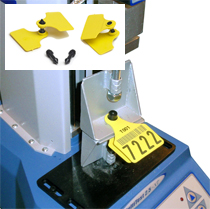
Animal identification tags are important for both legal and health & safety reasons where animal by-products are sold into the human food chain. The tags on dairy cattle are used to record data and trace the animals throughout the milk production process. The tags themselves, attached through the livestock’s ear, comprise of two flexible plastic leaves and a tamper-proof pin fastener. They must remain on the animal – and complete in themselves – when subjected to all expected in-service forces. Specific standards require testing for both tensile strength (by means of a transverse pull test) and pull-off/pull-out forces along the axis of the pin. The software–contolled test stand is able to hold the tags at a target load and then pull further at contolled speed (typically 500 mm/min) until breakage. Once failure occurs, the tags must be unusable as part of the traceability requirements. The transverse pull test can be performed with suitably rated tension wedge grips. The pull-out test on the pin can be achieved with custom grips designed to pull axially and support the leaf surfaces.
Mecmesin Systems: MultiTest console-controlled force test system, 5 kN wedge grips
Case Study: Animal Identification Tags

Scientific research in the sphere of physiology, anatomy and medicine has far-reaching impact on the health and well-being of humankind. The methodical application of testing and investigation into how biological systems behave and react to change allows the furtherment of medical science. The discipline of dentistry can employ mechanical testing to evaluate the bite strength of the mandible/maxilla system throughout the aging and wearing process, by repeatable compressive strength tests. One specific example uses a computer-controlled test stand to compress a plaster of Paris dome-shaped sample (which has comparable mechanical properties to hard, brittle food items, like nuts) to measure ultimate bite strength. Dental model attachments to the compression plate represent the tooth profile within the jaw and in addition to the force measurement, further evaluation of the fractured sample – size and number of fragments - also influence the scientific appraisal of mechanical performance. As the teeth wear, the profile changes and the effectiveness over time of the ability to fracture the foodstuff can be determined. The test program records the peak force at fracture and uses stop-at-break functionality to avoid damage and reset, then the output data is further analysed in Excel® - allowing the flexibility to continue research out in the field, by use of portable computers. The Emperor™ software’s ability record all of the data is invaluable in the thorough understanding necessary in a scientific project. Furthermore, this ethical engineering solution negates the need to experiment with living primate specimens.
Mecmesin Systems: MultiTest computer-controlled force test system, compression plate accessory
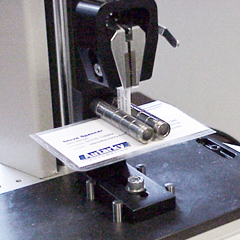
Products with bonded layers such as laminated security or ID cards undergo peel testing to check the integrity of the adhesive attaching the coating. Businesses in the home and office sector or manufacturers within the adhesives and coatings industries should quality test to these standards. A 90 degree peel test is applicable for samples where a more flexible bonded layer is pulled off a stiffer substrate at a right angle in order to determine the minimum force to peel the laminate. The test equipment must ensure that the 90 degree pull angle is maintained, with the substrate remaining horizontal and travelling laterally by means of a floating roller fixture or a moving peel table. The rigid substrate may negate the need for the support of a table, as in the case of a laminated ID or credit card. Flat jawed wedge or vice grips are needed to securely hold the coating layer throughout its vertical movement.
Mecmesin Systems: MultiTest motorised test system
Case Study: Delamination peel test
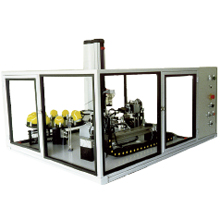
International sports organisations are responsible for the regulations governing their field of interest and these may cover a wide range of unique requirements. The sport of tennis has a number of court surfaces and also player levels from recreational through to professional which determine different criteria in terms of tennis ball characteristics. The fundamental performance measure of a ball is the bounce behaviour and this is directly influenced by its compressive deformation, size and weight. A customised automated computer-controlled system which is able to pick an individual ball and perform the compliance test, without human interaction, whilst capturing the results to generate a statistical report can then become an official approved test standard. In terms of the test specification for a tennis ball, the program steps include touching on the surface, exercising scragging before measuring the force through compressing to a specified ‘forward deformation’ (and relaxation) in 3 orthogonal axes. The process involves complex steps involving holding to certain load levels for certain amounts of time plus diameter and weight measurement. Challenges such as physically picking the next ball and moving the supply along require bespoke engineering solutions involving pneumatic grips able to grasp and to rotate to XYZ alignments, custom compression plates, a carousel dispenser and digital scales.
Mecmesin Systems: Customised force testing applications, Emperor™ (Force)
Case Study: Automated ITF tennis ball tester

The important attributes for cosmetic products are related primarily to aesthetics and texture. Colour depth, choice of lustrous shine or matte finish and the feel of the product upon application to the skin, for example, are key selling points for lipsticks. Of equal importance (but less obvious to the consumer) is the durability of the cosmetic through repeated application – influenced by composition. The bullet-style dispenser for lipstick must perform reliably under cantilever-type flexure loading through forces applied by the lip at the tip of the bullet, and resisted at the end of the barrel container. The test system must replicate the conditions under which the lipstick will be stressed – holding the dispenser firmly and applying the force with a special fixture to ensure the sample will break due to bending force rather than being cut. The lipstick may fail either in shear or by the classic pure bending compression/tension force distribution: this test will determine either characteristic in the sample. By repeatability and accurately measuring the peak force at break, the manufacturer is able to evaluate the effect of formulation changes upon the performance of the product, either for aesthetic reasons: improving colour, finish and texture, or for manufacturing changes such as using different raw materials. This bend test is also applicable to differing designs of the lipstick tip – bullet, bullnose or chisel – due to the design of the fixture.
Mecmesin Systems: MultiTest motorised test system
Case Study: Lipstick bullet breakage test

Manufacturers of golf shoes and aftermarket suppliers of replaceable cleats (also known as spikes), need to know that the cleats will remain in place under normal use, but can be removed for maintenance or replacement. In order to achieve consistent product quality, it is necessary to measure the breakaway torque as the cleat begins to rotate, and the maximum torque needed to fully release. In addition, when fitting the cleat the torque and angle at which the cleat locks or any over-ride torque can be determined. Up to ten cleats may be attached to the sole of the shoe and the ability to align each cleat with reference to the torque sensor is critical to the accuracy and repeatability of the test. A multipoint sample holder mounted on a gimbal coupled to an X-Y motion table is required to provide the range of movement needed to achieve correct centring. Top-load weights provide a constant axial force during measurement. A computer controlled stand controls rotation and collects torque and angular data. Modifying the control program for cyclic testing to assess any degradation due to repeated operation is a simple task.
Mecmesin Systems: Vortex-i computer-controlled torque test system
Keypad push-buttons are important componentry on many electrical and electronic products. Mobile phones, keypad entry systems or industrial machine controllers all have functional reliance on the reliability and longevity of these components. Testing the life-span for the keypad through repetitive actuation of the buttons requires automation to repeat the compression test cycle to either failure detection, a measured drop in the value of a significant parameter, or a specific number of cycles – at which point the component may be inspected visually and for degradation in functionality. A simple force gauge may be used to determine appropriate loading. The added flexibility of being able to specify the correct compressive force for different keypad implementations can be programmed into a software-controlled system.
Mecmesin Systems: Digital force gauge, Emperor™ (Force)
Case Study: Mobile Phone Keypad Life Test

Textiles, cloths and fabrics used in both clothing and sporting markets have requirements for flexibility and lightness, but also durability and resistance to breakage – particularly tear damage – when in use. A hot air balloon manufacturer must conform to strict standards, applicable to the aerospace industry despite the textile construction of the product. The variation in coatings for the fabric – due to individual designs – and the fabric itself, requires that the test procedure must be applicable all cases. The strip method tear test for fabrics evaluates tear propagation resistance under constant loading at a constant rate of displacement. For secure retention of the standard size samples, wave-form jawed grips would be suitable, capable of holding the fabric across its full width, up to forces of up to a peak of 350 N, in this case. This tear test may be used as a standard method for measuring the effect, not only of wear-and-tear on the textile, but the impact of sunlight aging the material over time. The same system of a motorised test stand, digital force gauge and results analysis software, plus the versatile grips can also be used to measure the tensile strength of the numerous seams and fastenings of the fabric structure.
Mecmesin Systems: Motorised stand with gauge and software, large vice grip
Case Study: Balloon Cloth Tensile Strength Test
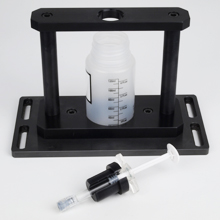
Medical device manufacturers operate in one of the world’s most competitive and highly-regulated industries, where success and lives hinge on compliance to standards, time-to-market and results traceability (raw data retention). A robust audit trail is important for the OEM if the customer has a product problem in the future. Syringes must deliver and extract fluids in a smooth, controlled manner; a plunger that is too easy or hard to actuate, or that stalls or judders on depression will not perform reliably during injection or aspiration. The testing of manually operated sterile single-use hypodermic syringes for glide (in both aspiration and expression strokes) force is essential under industry standards. These forces will be determined by a range of variables, the size of the syringe/needle aperture, the ‘fit’ of the plunger within the syringe barrel, the materials used and, in service, the density of the tissue substrate and the viscosity of the liquid. The syringe must be developed with the optimum balance of these variables to assure consistency and usability. Typically, a constant rate of plunger depression (and withdrawal) of the order of 100 mm/min is indicated for this test. A compression tester should be employed that deals with security – a log on for operator identification - and software to accurately control the plunger displacement and record the data. A fixture to grasp the finger flange for tension and compression strokes, with adjustability for syringe sizes, may also be required.
Mecmesin Systems: Touch screen test systems, Emperor™ (Force)
Video: Syringe plunger actuation force
Standard: ISO 7886-1

The 6% conical taper Luer connector for syringes, needles and other medical devices can be push/pull taper only, or a taper and screw (“Luer lock”) fitting. Light assembly and disassembly torque to turn is required to seal so that even a child could use successfully, whilst remaining leak-proof. However, a successful seal at low torque improves at higher torque. In the case of Luer locks, torque assessment should be performed on a low-level torque testing system, with a motorized base plate and a low capacity (e.g. 1.5 Nm) torque transducer. The most common test involves tightening the Luer lock connection between a needle housing and a fluid-filled syringe to a pre-determined torque, and visually inspecting the joint for leakage. Universal gripping pegs may be used to hold the sample in place, although customized fixtures ensure greater accuracy and repeatability – keeping the sample concentric with the torque axis is an important consideration. A floating fixture, or similar, to allow secure location into the needle attachment component should also be employed. For in-house quality standards compliance, a semi-automated syringe tester using a touch-screen controlled torque testing system which can be programmed with acceptable limits for the syringe is recommended. The operator is presented with a colour coded pass/fail result for easy identification of the sample status.
Mecmesin Systems: Touch screen torque test systems, Emperor™ (Torque)
Video: Semi-automated syringe tester
White Paper: An Examination Of Needle And Syringe Force Testing

The foil lid of blister packaging must allow separation in normal use by means of peeling the flexible layer from the formed container without tearing. The adhesive strength of the bond should facilitate this ease of opening and also guarantee the reliable sealing of the product within, which may be a liquid or gel with hygiene or sterility requirements in the pharmaceutical or food industries. Peel testing of these packages to external or internal standards has several challenges in order to replicate the actual manner in which the elements are separated in service and to repeatably focus the test of the adhesive characteristics of the bond itself. Maintaining the peel angle (initiated at 135 degrees) to within the desired specification may require the design of a custom fixture – a jointed chain can effectively replicate the manner in which a consumer will apply the tension to the lid. Grasping of the corner of the foil in a manner akin to human fingers will require suitably sized pinch grips. In order to focus the test on the bonding around the blister perimeter, the surface needs to be kept flat and in a non-deformed condition, to avoid introducing inaccuracies into the process and ensure repeatability. The use of a pneumatically-activated vacuum fixture specifically moulded to the blister profile is the reliable solution.
Mecmesin Systems: Touch screen force test systems, pinch grip
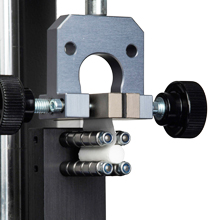
The testing of adhesive tapes and coatings present challenges for the product manufacturer in any industry, as the procedure itself must test the performance of a thin layer of bonding and often handle a flexible adherend on at least one surface. Peel resistance is the primary type of test for these bonded products and both international industry standards and internal checks demand the secure location of the sample whilst also allowing resistance-free relative movement between the adherends to enable the relevant layer to peel without obstruction. A manufacturer of filters for customers in the tobacco industry has varying specifications for the brands it supplies and the health and safety implications of such products (they are in contact with the mouth) also means that legislation is constantly evolving, with impact upon the manufacturing process and raw materials. The delicacy of the components (cellulose acetate filter and paper coating) requires consideration in the design of test fixtures to quality assure the peel resistance. Four locating dowels mounted on light needle roller bearings ensure that the rotation of the sample is as friction-free as possible and able to float within the fixture, as the paper coating is pulled vertically at a constant rate to unwrap. The locating fixture itself is securely anchored to a modified anvil base plate. This internal test is closely related to the 90 degree peel, floating roller, climbing drum and German peel wheel tests, but has been developed to meet the unique situation of the cigarette in service. Software captures the peak force, or any other measurable attribute that the manufacturer or customer needs.
Mecmesin Systems: Computer-controlled force test systems

Improving the reliability of the yield of foodstuffs is of global concern to the agricultural industry. An increase in the variety of specific dietary requirements for an individual’s health choice and the need to cater for population growth mean that achieving high quality yield from crops is essential. One reason for crop failure is lodging or permanent displacement, where the individual plant bends to lie flat on the ground – or displaced enough through flexure from upright to be unable to be harvested in an efficient manner – causing any number of remedial actions at cost to the crop-producer. Whether the lodging is caused by wind, soil composition or other factors, the application of a scientific approach to the forces and torques which the actual plant can resist will improve the understanding and ultimately success rate of the yield. The shots are considered cantilevers, anchored at their roots into the soil. The ability to test the crop bend flexure in the field necessitates not only a scientifically designed test, but also custom-engineered equipment which is simple, reliable, robust and portable. A tool to apply a controlled torque and an accurate digital gauge to measure of fundamental mechanical attributes of the shoots: centre of gravity, balance point and gravitational moment will allow food producers to evaluate the effects of changes to the processes which can influence the plants themselves, from nutrition to genetics.
Mecmesin Systems: Static torque screwdriver, digital force and torque indicator
Case Study: Testing roots and shoots
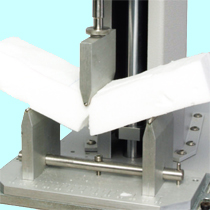
A manufacturer of performance sports equipment, which is then sold on to customers in its own supply chain for final production design, must ensure that the fundamental product meets the highest quality standards. The polyurethane (PU, PUR) foam used for the manufacture of surfboard blanks is subsequently coated for various design reasons, but the fundamental strength characteristics should assure safe, reliable performance for this lightweight material. For the manufacturer to provide a guarantee of product performance to its customers and to also obtain objective judgements regarding the raw materials received from its own suppliers, a repeatable, representative strength test is needed. The localised forces exerted by the surfer on the upper side of the board and the more generalised forces from the wave on the lower surface result in 3-point flexure being the relevant test type to measure the rigidity and strength of the product. A 3-point bend jig, with adjustable lower support arms and the capability of friction-free force application can be used to accurately apply the flexure symmetrically across the sample. A constant axial compressive load is produced by means of a constant speed application of the blade by the motorised test stand. Connection of a digital gauge and graphical output from software enables the manufacturer to compare the peak load data for different board constructions.
Mecmesin Systems: Motorised test stand, gauge and software combination, 3-point bend fixture
Case Study: Surfboard 3-point bend test
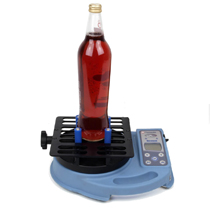
The ROPP design of glass bottle cap is a popular solution for drinks manufacturers and brewers, featuring pilfer-proof indication by means of a tamper evident ring. The metal closure has a liner to ensure hermetic sealing to prevent leakage and preserve flavour, freshness and gas content of sparkling varieties. To quality assure the capping process is providing an application force and torque to achieve these objectives, whilst still achieving in-specification removal torque, a portable digital torque test instrument may be used at the point of production. An adjustable saddle plate and fixing pegs will allow a variety of shapes of bottle to be quickly accommodated and tested. For additional convenience, repeatability, and ease-of-use – important considerations in rapid through-put automated manufacturing environments – is an audible pass/fail indicator and the ability to connect the instrument to results analysis software and transfer stored data. The closure torque values typical for this solution mean that the simple application of removal torque by hand is possible, rotating the closure through the breakaway and bridge torque points, providing an efficient and representative test standard.
Mecmesin Systems: Tornado digital torque instrument, large saddle plate, adjustable fixing pegs
Case Study: ROPP bottle cap removal torque test

The extraction of the cork closure from a glass bottle of Champagne, or similarly sealed sparkling wine, must be able to be performed easily enough to successfully release the beverage for consumption. As with all drinks containers, the stopper has to provide effective sealing to ensure the product remains in perfect condition, free from leakage (even after horizontal storage) and as freshly fizzy as when originally bottled. Additionally, the natural cork material should remain intact under the closure's removal torque required. A prime objective of a testing system to allow repeatable measurement of the peak release torque, suitable for a governing body responsible for evaluating the consistent quality of all products, is to reduce wastage in testing the full bottles of wine. A reliable quality assurance process needs several functional requirements. The ability to securely hold varying bottle sizes – magnum, standard (75cl) and demi – requires a design of fixture with quickly interchangeable jaws, able to grasp different radii and locate glass samples without slippage. Pneumatic operation of the clamps further enhances the efficiency of the method. The clamping of the cork within the upper fixture, must similarly be secure plus allow the cutting of the muselet wire prior to operating the test. The motorised system is geared to rotate the upper fixture as the bottle is simultaneously lowered at a constant speed. This complete, flexible, automated solution includes a safety enclosure to guard against spillage.
Mecmesin Systems: CombiCork-d, Advanced Force and Torque Indicator
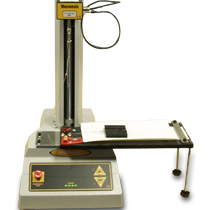
Mass production of goods often involves the transfer of items through the machines and transport mechanisms of the manufacturing process. Efficiency can be lost if the items misfeed or otherwise fail to move smoothly between operations. Consumer packaging used in the packing and shipping of products is affected by the frictional properties between the packaging material itself and the surfaces upon which it needs to slide. A specialist test solution to accurately measure the forces required to overcome the static and kinetic friction between the two surfaces enables the production organisation to evaluate different materials. Furthermore, this information then affords optimisation of machinery settings. A computer-controlled solution would involve a flat table upon which to locate the material sample, across which a block (‘sled’) of known mass is pulled by the test program. The force needed to initiate the movement is a function of the static friction (‘stiction’), the calculation of the average force to then maintain movement indicates the kinetic friction. The graphical output can also give an indication of the material’s propensity to cause judder or other undesirable characteristics.
Mecmesin Systems: Computer-controlled force test system, test hook
Case Study: Coefficient of Friction Test
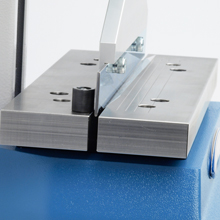
To maximise the service life and optimise the functionality of electrical systems – generators, motors, etc. – the electrical insulation component is vital. Often in the form of tapes, comprised of combinations or layering of polyester, mica (or mica paper) and glass fibre, these elements must have a certain degree of flexibility in their mechanical properties and prevent electric flashover and conduct away any dissipated heat. International electrical standards define specific tests to measure the stiffness of insulating materials based on mica. To meet these standards a purpose-built tape bend fixture will be required which performs a 3-point bend along the axis of the tape test specimen. The insulation film, mica uppermost (if layered, with the faced material uppermost) is placed symmetrically over a 5mm wide slot in the support platform and a tapered penetration bar is lowered until a peak resistance force is achieved. The stiffness is defined as a rigidity calculation – the ratio of maximum flexural load to sample length. The test for an individual product type is performed on 5 representative samples and the mean, maximum and maximum calculated rigidity values are reported for compliance, in addition to the temperature conditions (required to be 23 °C ± 2 K) and humidity.
Mecmesin Systems: MultiTest console-controlled force test system
Standard: IEC 60371-2
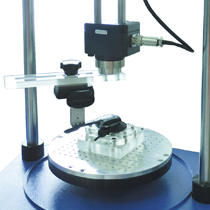
Electronic communication devices are designed to be comfortable and ergonomically efficient in their usage, especially in environments where the product may be worn for extended periods – for example by company contact centre agents. The microphone arm of hands-free headsets may be designed to deploy and stow as needed, and as such must do so in a precise manner with positive engagement, yet operate with a light enough torque to turn to not require excessive effort in prolonged, repeated use. The implementation of a computer-controlled torque test system provides a manufacturer’s Research and Development department with the flexibility to create a suite of test programs for an extended product range. Custom fixtures to attach to the torque cell may be built to accommodate a variety of designs (over or on-ear, wireless, Bluetooth) and sizes (mini, ear-clip or full-size over the head) to swing the component through its complete arc. An adjustable lower table fixture also must securely locate the body of the headset. Interchangeable torque cells will allow accurate measurement for various models – production or prototype designs. The software should be programmed to report the salient characteristics of the torque curve – peaks to initiate the rotation and locate the arm into the home position as well as the peak and average effort in the main stage of the actual rotation (running torque).
Mecmesin Systems: Conputer-controlled torque test systems, Emperor™ (Torque)
Case Study: Headset Microphone Joint Torque

The action of brush bristles in any in-service situation is quite a complex system. Many forces are applied, often in multiple directions and the action of frictional forces also has an impact on the durability of the product. In addition the retention of the bristles (filament shedding performance) is an important consideration. A simple manual toothbrush is subjected to these conditions, as well as industry test methods applicable to cosmetics and personal health – specifically dental equipment standards. A versatile and complete testing solution should be able to perform the bristle stiffness test, in which the complete brush tufted area is rubbed against a metal grid at constant speed – subjecting the bristles to a cantilever bend force. The forces recorded then categorise the toothbrush into consumer categories from soft, through medium, to hard. Shedding performance can be measured by pull-of/pull-out for individual filaments or a ‘tuft’ of bristles with a surgical clamp and a pin chuck fixture, respectively. Location of the toothbrush head should be secure in order to eliminate flexure in the plastic (polypropylene) housing itself. A robust console-operated system would allow testing in a mass manufacturing environment, with simple operation for production staff, giving the confidence to meet stringent quality standards.
Mecmesin Systems: MultiTest console-controlled force test system
Case Study: Toothbrush Stiffness Tester

The 6% taper Luer lock-type of fitting (screw or lug) for syringes, needles and other medical devices has the primary purpose of ensuring a leak-free connection in delivering fluids. For systems using semi-rigid materials (e.g. plastics), the relevant standards require a specific metal conical reference fitting to be used, either male or female, to test both parts of the connector, ensuring control over dimensions and tolerances. A test system which is able to accurately apply a top-load axial force is required (27.5 N), with the simultaneous application of a very small torque value of 0.12 N.m. There are additional considerations in the design of an automated, purpose-built, test system for these standards, which are validating that the fastening torque is satisfactory to achieve the seal. Namely, the provision to supply the fluid to the Luer component and to a stipulated pressure for the liquid leakage standard, or to draw fluid into a syringe to a percentage of its capacity for the air leakage during aspiration (filling) test. The testing for liquid leakage requires the application of an effective internal water pressure of between 300 kPa and 330 kPa once assembled to the reference fitting. Visible inspection for leakage is then performed – falling drop of liquid or continued formation of air bubbles.
Mecmesin Systems: Helixa precision torque test systems, Mecmesin purpose-built test systems
Applicable Standards: ISO 594-2, BS EN 1707, BS EN 20594-1 ISO 80369
White Paper: An Examination Of Needle And Syringe Force Testing

The 6% (Luer) lock-type of conical tapered connector, used in fluid delivery systems in the medical field, must ensure leak-free performance at all times. Whether in hand-held syringes or other devices, such as infusion pumps supplying nutrients or medication, the seal must remain intact so as to provide the exact dosage – and this unscrewing torque test evaluates the device’s resistance to coming apart. The testing standard for semi-rigid versions of Luer components requires precise assembly of the connector under inspection (male or female) to a metal reference fitting prior to performing the specific functional test - 27.5 N top-load and 0.12 N.m torque. Due to the light loading values required for these devices, a precision test stand is needed. The unscrewing torque test requires that a very small torque (0.02 +0/-0.002 N.m) is applied and then held for a minimum amount of time. Precise alignment is essential to ensure than no other forces occur along any other axis, and the test stand must be able to provide this level of control. The Luer connector must remain attached to the reference fitting to comply.
Mecmesin Systems: Helixa precision torque test systems
Applicable Standards: ISO 594-2, BS EN 1707, BS EN 20594-1 ISO 80369
White Paper: An Examination Of Needle And Syringe Force Testing
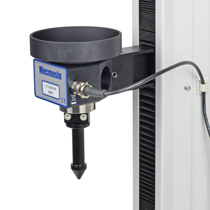
Medical device connectors with a Luer lock (6% taper), which are manufactured from semi-rigid materials, are subject to an ease of assembly test under industry standards, which stipulates precise application force and torque values. Rigid devices need only be assembled to the definition of “secure”. To assemble the Luer lock to the metal reference fitting (27.5 N top-load and 0.12 N.m torque), connectors made of plastic require a test stand which is then capable of simultaneously imparting an axial force, not exceeding 20N, on the screw fitting together with a small torque, not exceeding 0.08 N.m. The connector should completely assemble under these loads to pass this specific fastening torque test.
Mecmesin Systems: Helixa precision torque test systems, Mecmesin purpose-built test systems
Applicable Standards: ISO 594-2, BS EN 1707, BS EN 20594-1 ISO 80369
White Paper: An Examination Of Needle And Syringe Force Testing

Connector components of a fluid delivery system must be able to be assembled quickly and reliably in the medical and healthcare environment. The Luer lock solution is threaded (or has a lug) and more secure than the Luer slip-type and so must be able to be easily screwed together to provide a leak-free seal, that will not be compromised by under or over tightening – and verified by fastening torque testing. The relevant standard refers to the latter condition as overriding, and repeatable testing to this standard requires the precise application of a 0.15 N.m torque to the component in the tightening direction. This torque must be held constant for 5 seconds and the test stand program must be able to facilitate this condition. As with the related Luer lock tests, the sample must first be assembled to the reference fitting by a simultaneous maximum axial force of 27.5 N and a light maximum torque of 0.12 N.m torque prior to the overriding torque application
Mecmesin Systems: Helixa precision torque test systems
Applicable Standards: ISO 594-2, BS EN 1707, BS EN 20594-1 ISO 80369
White Paper: An Examination Of Needle And Syringe Force Testing

The performance of Luer locks (6% conical taper connectors with a screw thread or lug method of assembly) must be maintained throughout the duration of their use in the fluid delivery system. These medical devices are designed to ensure a leak-free condition, whilst being quick and easy to remove and replace as demanded by the patient’s treatment program. In addition to tests focusing on the assembly of the connector, industry standards also prescribe tests to meet durability demands while connected at a reference fastening torque. This particular requirement needs a test stand capable of applying both a torque (0.12 N.m) and an axial force (27.5 N) held for 5 seconds, to assemble the Luer lock initially. To complete the stressing of the components, a constant temperature of 20 ± 5 °C (27 ± 5 °C in tropical climates) is maintained for a period of 48 ± 1 h. The components should be free from cracking at the completion of the test. Additional consideration should be given for specific environmental conditions applicable to the device’s use – which may include contact with chemicals in addition to elevated temperatures.
Mecmesin Systems: Helixa precision torque test systems
Applicable Standards: ISO 594-2, BS EN 1707, BS EN 20594-1 ISO 80369
White Paper: An Examination Of Needle And Syringe Force Testing

The 6% taper Luer lock-type of connector has widespread use for hypodermic syringes, needles and with certain other apparatus for medical implementations, such as transfusion equipment, for the delivery of fluids. For systems using semi-rigid materials (e.g. plastics), the relevant standards require a specific metal reference conical fitting to be used, either male or female, to test both parts of the connector. The testing of separation (pull-off) compliance requires that the element of the connector under test remains attached to the reference fitting. The Luer component is first applied to the reference fitting by a maximum axial force in conjunction with a precise, small value, maximum torque (27.5 N top-load and 0.12 N.m torque). Once located, the test must apply another strictly axial force away from the test fixture at a constant rate of 10 N/s up to a maximum value of 35 N and for a minimum time of 10 s, in order to evaluate the pass or fail condition for the pull-off test. The subsequent part of the method may require a different test stand to complete the full quality assurance process to acceptable accuracy, due to the significantly different force values to that required to locate the fitting initially. A constant rate of traverse system can achieve the necessary force application rate by prior testing to equate the displacement rate for the sample type under inspection.
Mecmesin Systems: Helixa precision torque test systems and MultiTest motorised test system
Applicable Standards: ISO 594-2, BS EN 1707, BS EN 20594-1 ISO 80369
White Paper: An Examination Of Needle And Syringe Force Testing
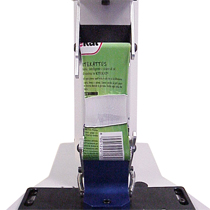
The effective sealing of food items with plastic film relies on a degree of flexibility and strain within the film in order to enclose and achieve air-tight packaging. A two layer construction, with the outer layer bearing the printed product information, may be quality verified for integrity by a tensile strength test. The packaging material should exhibit a degree of elasticity, but still meet expected levels of tensile strength before breakage. The challenge to securely hold the sample without slipping or damage the thin material is achieved with spring-loaded roller grips. A motorised force test stand with a digital force gauge and software is a repeatable solution for measuring the peak force to break apart the plastic layers under constant speed loading. This compact system is ideal for the quality control or research laboratory.
Mecmesin Systems: M500E motorised test stand with gauge and software, spring-loaded roller grip
Case Study: Plastic Film Tension Test
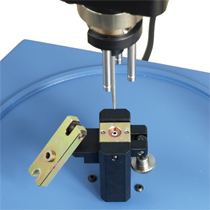
The components in rotating machine tools which are designed to work on materials, need to remain securely located in order to accurately wear the target surface. Small abrasive disks used in the dental industry (to shape implants), should be tested for integrity by evaluating their resistance to an applied torque to turn created between the implant surface and the driving spindle of the tool. Using a custom-designed adaptor, the abrasive disks may be tested to check that they do not become loose on their central hub when in service. Should the breakaway torque be less than required standards, the supplied batch can be rejected. The disks are marked clearly prior to being loaded onto the adaptor to show any subsequent rotation. The adaptor securely clamps the abrasion surface itself and a custom probe is lowered into the spindle bore. The software program rotates the locked probe 90 degrees clockwise and 180 degrees anti-clockwise. If the disk has rotated in the hub, then the component fails. Slippage around the spindle or rotation against the fixing (much less likely) would show no indicated disk rotation. The torque is measured and the test results graphically displayed to further quantify the level of discrepancy between specification and achieved peak torque.
Mecmesin Systems: Vortex torque test systems, EmperorTM (Torque)
Video: Dental abrasive disk testing
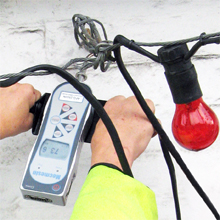
Electrical lighting displays which are erected on buildings in public areas, such as seasonal illuminations, are subjected not only to specific electrical standards, but also legislation surrounding their installation, operation and removal. The fastening hooks/eyelets securing the cables to buildings or other structures must resist tension forces designed to test pull-out from their anchoring and tensile strength of the attachment or its bolts. Due to the location of these anchorage points – usually in high-up or relatively inaccessible spots – a test system with the emphasis on lightness and portability is required. The ability to also store multiple readings within the gauge’s on-board memory, ensuring traceability of the measured peak force values back to individual fastenings, should also be a requirement. The data may be analysed offline to evaluate the entire electrical system’s integrity once the gauge has collected the information. For additional safety consideration for the operator, a handle for the gauge should be employed.
Mecmesin Systems: Digital force gauge, manual handling kit
Case Study: Festive Lighting
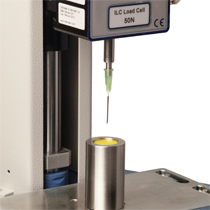
The medical devices and associated services industries are subject to strict quality standards testing. The complete life-cycle of the equipment is covered, including the safe disposal of used, contaminated items. Manufacturers of products involved with the safe discarding of medical devices with needles (‘sharps’) must conform to British Standards to provide proof against puncture by clinical waste materials. These sharps bins will be handled by staff from several organisations in the chain, not all specifically trained in medical practices, thus safety must be assured against the puncture of the container material by the waste. A puncture resistance testing process should allow a variety of sample types – specifically material thickness – to be securely located by means of an adjustable base fixture that has sufficient clearance to drive the needle point a certain distance through the surface of the standard diameter sample. An extension rod to fit the syringe hub is required for the crosshead fixture. Measurement of the peak force applied to create a breach can be achieved with computer controlled test programming and run from a touch screen console with each unique test associated with a sample type.
Mecmesin Systems: MultiTest touch-screen test system

The seals on tamper-proof (or tamper-evident) closures are designed resist an unscrewing torque up to a specific value. The tamper-evident band on the cap should remain intact for safety reasons, until it is positively breached and the bottle opened for intended purpose. Testing of this bridge torque for a range of products is needed to optimise the balance between ease of opening and security. Testing the cap designs in isolation from the bottles themselves in a product design environment can be achieved through the use of bespoke mandrels in the standard manufactured sizes produced by the supplier. These fixtures ensure a repeatable grasp of the cap and a precise hold of the tamper-evident ring for confident back-to-back testing of design variants. A digital torque indicator gauge, with on-board memory - for storage of the peak torque - and data transfer capability allows the collection of results for analysis.
Mecmesin Systems: Advanced Force and Torque Indicator, torque mandrels
Case Study: Torque Tester for Dedicated Caps
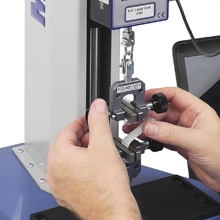
All sterile medical devices require validation of their packaging. The flexible sterile barrier must be shown to be effective throughout the product's claimed shelf-life. The integrity of seals and welds is of critical importance and the testing of the bonding strength of these seals is often performed by peel test, the flexible material on both layers necessitating either 180 degree or T-peel. These tests are also relevant to package openability and evaluating the manufacturing processes’ ability to produce consistent seals and the peak force and/or the average force to open the seal may be relevant. Inspection after the test may reveal either the adhesive has failed to adhere to a substrate (adhesive failure), in which case the bond strength has been measured. Conversely if the bond has failed internally (cohesive failure), or the packaging material has delaminated, torn or failed in another manner, then the test has exposed deficiency in the overall specification of the seal. Usually a representative strip is cut across the seal of a standard width and a T-peel is performed. An important consideration in the fixture design may be to mitigate against bending – by supporting the unpeeled portion of the sample at 90 degrees to the peel direction.
Mecmesin Systems: MultiTest console-controlled force test system, lightweight double-action vice grips
Standards: ASTM F-88, EN 868-5

The performance, durability and safety conformance of clothing must reflect the multitude of styles and materials mix plus functional and decorative additions. These various embellishments: buttons, ribbons, bows, sequins, diamante and other fastenings that have been attached to textiles need to be checked that they have been safely affixed so they will not become choking hazards for infants, for example. The necessary test-to-failure (TTF) indicated by the standards – a code of practice for the design and manufacture of children's clothing to promote mechanical safety – involves pulling the feature until it detaches. The method tests the pull-off/pull-out and tensile strength of the product and also recording the displacement of the crosshead will give a measure of the elongation at break. A selection of grips may be required for securely grasping the decoration – with hooks or slots – depending on the design.
Mecmesin Systems: MultiTest console-controlled force test system, digital force gauge, test hook, popper-cam base
Case Study: Diamante Pull-off Test, Bow Pull-off Test, Button Pull-off Test, Press-Stud Popper Pull-Off Test
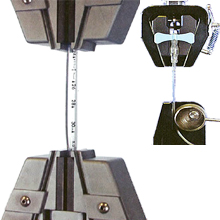
Plastic extruded medical tubing is an essential health care product for the delivery of blood, nutrients and gases to the patient, and for the execution of minimally invasive surgical procedures. The tubes, for example catheters, may also be connected to other medical apparatus such as Luer devices, butterfly valves and pipe junctions. A manufacturer of these products must meet strict regulatory compliance in conjunction with optimising the functional design - for efficiency plus patient comfort and safety - while also meeting production costs. An in-house quality testing regime should consider the in-service forces exerted on the individual components and the complete system of which the tubing will be a part. The tubing itself can be tested for tensile strength and elongation behaviour with a force test stand and a selection of appropriate grips and fixtures pertinent to the product’s performance requirements in situ. A computer-controlled system is perfect for an OEM’s research and development lab, allowing the collection of results and bespoke test programs applicable to a range of products. The challenges to reduce the wall thickness to minimise trauma and maximise the lumen bore to maintain flow capacity can be met with structured, repeatable quality testing processes.
Mecmesin Systems: MultiTest computer-controlled force test system, 5 kN wedge grips, bollard grips
White Paper: Force Testing Medical Tubing

The tamper-evident caps on bottles are designed to resist breaching through unscrewing torque and/or pull-off force until opened for intended purpose. Correct opening requires unscrewing, with the option of resealing again for consumer convenience. The integrity of the tamper ring may also be tested against other removal forces experienced in transit or mishandling that would compromise the intended functionality. A peak force test to pull the cap (without rotation) until the tamper-proof band breaks away may be used to evaluate the design with respect to in-house standards. A console-operated system is convenient for production environments, with simple touch-screen operation to run a programmed test procedure. To augment throughput efficiency a custom-built fixture which allows one sample to be tested whilst another is loaded may be implemented. The cap is pushed over the fixture collar, manufactured to replicate the exact profile of the bottle neck. A concentrically-mounted compression probe is driven down through the sleeve, engaging inside the cap and compression-loading it until one or more of the tamper ring’s bridges fail. The recorded peak force reflects the overall tensile strength of the bridges and may be used to compare designs or supplier batches.
Mecmesin Systems: MultiTest console-controlled force test system, Emperor™ (Force)
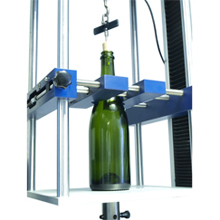
The bung used to stopper a beverage bottle must provide a leak-free seal to protect and preserve the liquid contents, whilst still allowing an ease-of-opening to access the contents. The removal process may involve a combination of pulling force and some rotational torque in practice, however to implement a repeatable quality assurance test, a standard method must employed. The axial force of extraction gives a consistent indication across different samples and provides greater simplicity of test procedure than mixing the pull-off/pull-out force and torque elements. An adjustable clamp to grip the glass bottle and a quick change fixture enable the versatility to test different categories of container from standard to magnum, as necessary. A chain link assembly connected to a suitable cork screw is used to locate into the plug material and apply the tensile load via the crosshead. Software control of the test stand and the ability to clearly indicate a pass or fail condition complete this system for reliable and accurate closure testing.
Mecmesin Systems: Force test systems, Emperor™ (Force)
Videos: Combi Cork Extraction Tester

The butt joint is inherently the weakest category of joint between two components, especially if a reinforced type is not used. The tensile strength of the connection is wholly dependent upon the bonding system, whether this is in contact with raw materials or the adherend is the coating on the surface(s). This type of joint has applications in many industries, from wood-working to large engineering systems. With metal components, welding is an option, however the advantage of a glue-based system is that it allows the full surface area of the butted faces to contribute to the strength. The overall failure of the joint under pull-off loading may be cohesive (where the glue suffers a lack of integrity) or adhesive failure at the glue/coating or coating/material connection. The latter is indicative of deficiency in the coating process, or evidence of the bonding agent having a detrimental effect on the coating. A butt joint test system must be capable of exerting enough force to break the butt joint apart, perfect axial alignment and deal with the possibility of a sudden catastrophic failure of the joint.
Mecmesin Systems: MultiTest computer-controlled 50 kN machine
Case Study: High Performance Plasma Coatings
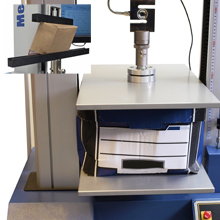
Boxes for the consumer and transit packaging industries must be as light as possible whilst still retaining a robustness to contain and protect their contents and also have the strength to stand up to shipping, handling and stacking requirements in service. The use of corrugation adds rigidity to paper and card packaging materials, which are tested in compression with several crush testing / top-load standards, namely the box crush test (BCT) and the related edge crush test (ECT) and stacking crush tests. Suppliers may also require modified tests to suit specific customer’s needs, as transit packaging particularly can undergo a variety of loading during its journey. The international industry quality assurance procedures for the box compression test may require self-levelling compression plate(s) in order to follow the pattern of failure, or some standards stipulate only the upper must be spherically pivoted to meet this requirement. Other standards indicate rigid compression plates when loading opposite sides (or corners) of the box. The BCT test loads the box at a constant rate to a nominal compressive load, or until the container collapses. In-house testing may use custom fixtures to load the box for unique crush situations such as edge to opposite edge.
Mecmesin Systems: Force test systems
Standards: ISO 12048, BS EN 22872:1993, ISO 2872:1985
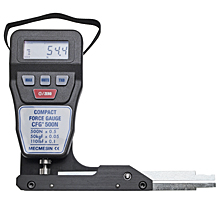
Moving components in transportation systems are critical in the safety of the passengers using the systems. Doors, windows, shutters and other sub-systems that open and close are all potential sources of accident or injury through misuse or potential malfunction. A public transport system, such as a train or similar transit vehicle with multiple carriages and sliding flush-fitting entry/exit doors would require a portable and simple, but representative test procedure to measure the maximum pinch force of all the doors. An effective solution involves a custom, cantilever activated arrangement which can be placed safely (for the operator) between the doors and loads the digital force gauge. The selected gauge, dependent upon features and functionality, may be set to immediately register a pass/fail result and audio warning.
Mecmesin Systems: Compact digital force gauage (CFG+), Advanced Force Gauge (AFG)
Case Study: Train Door Closing

The solder joints on a printed circuit board (PCB) are small and potentially delicate but must be able to withstand handling during the production process. Hand soldering production methods for such small elements is highly skilled, requiring extensive manipulation of the components and thus risk of break-off. In addition to pull-out testing, the joints are subject to compressive shear loading. International test standards exist for this type of mechanical compressive shear stress. The loading probe must be exactly aligned with the surface of the substrate in order to create the shear plane and not place the joint under a bending load instead. To test multiple joints on an intricate board design, a custom system may be required to quickly align all of the joints with the fixture at the specified angle. Selecting a loadcell of appropriate range to record the best accuracy is also a consideration – these tests may need to measure forces of around 300 N.
Mecmesin Systems: MultiTest console-controlled force test system
Case Study: PCB Pull & Shear Test
Standard: IEC 62137
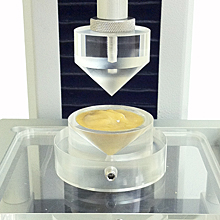
The mechanical properties of food and most cosmetics are more readily termed texture (also mouthfeel in the case of foodstuffs). The way these products are acted upon by forces determines the exact texture attribute, such as firmness, stickiness (adhesiveness) and spreadability. As such these items may be mechanically tested and the results used to quantifiably compare the effect of relevant production and manufacturing factors - for food: cooking time, relative mix of ingredients – on the consumer’s sensory perception of texture. The engineering concept of penetration resistance has direct correlation to the texture attribute of spreadability and the use of a cone-shaped penetration probe for a force test will allow repeatable and accurate texture analysis of a product judged by this quality. The matching container fixture for the sample is influential in the results as its degree of resistance to allowing the product to spread freely, but enables consistent comparative testing. Typically this fixture is shaped as an internal cone corresponding to the same dimensions (90 degree vertex angle) as the probe.
Mecmesin Systems: MultiTest force test systems, compression fixtures
Case Study: Margarine Spreadability
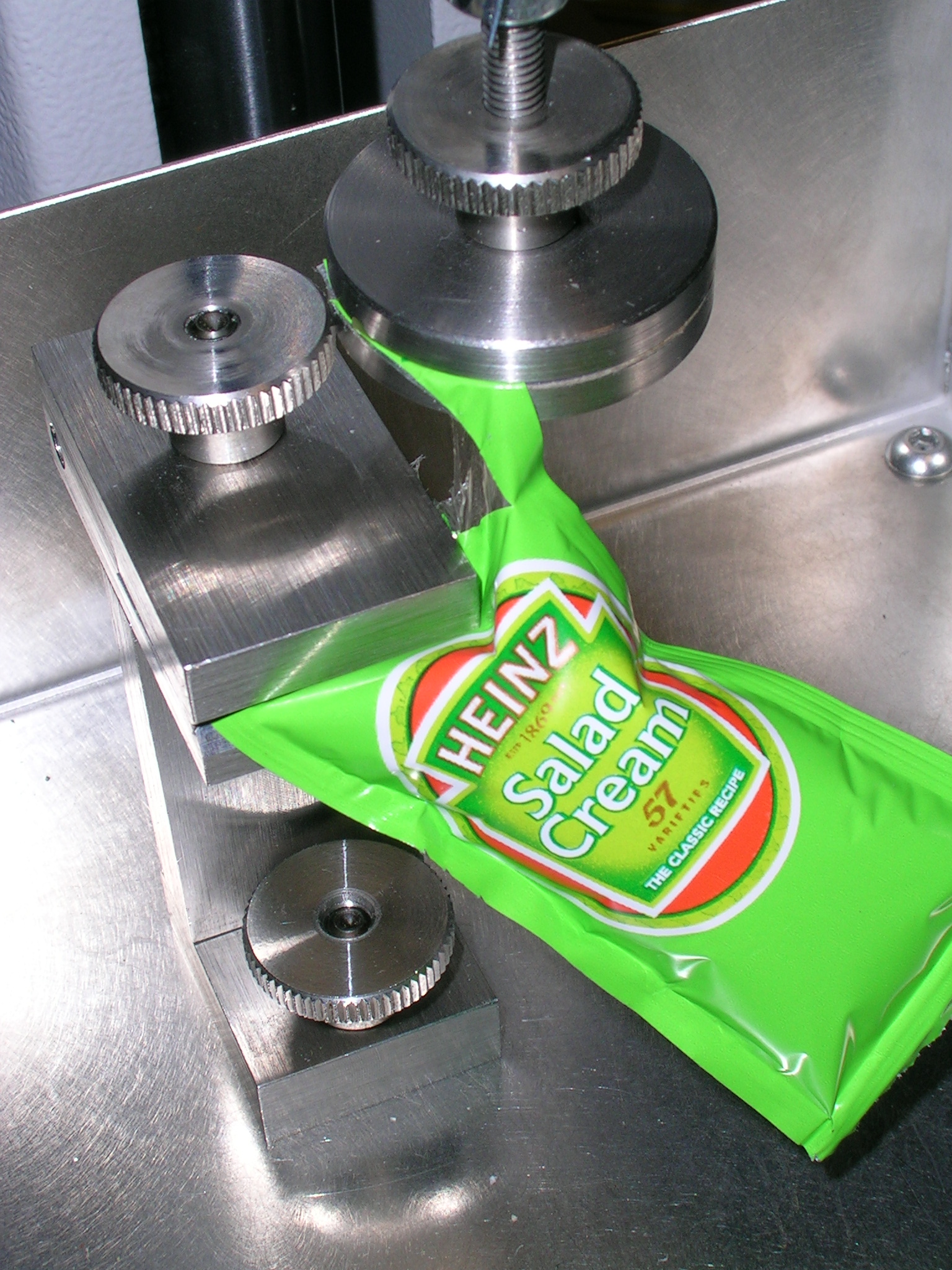
Sachets are convenient forms of packaging, as they are easy and quick to open and the ideal size for delivering small quantities or trial sizes of products. They are used as packaging for products from industries such as cosmetics and pharmaceuticals as well as food products such as condiments. Manufacturers need to ensure that their sachet packaging is strong enough to protect the contents through all stages of the manufacturing and distribution process, while remaining easy to open for the consumer. Tests carried out to ensure the integrity of the sachets include tear strength and tear resistance. These tests measure the strength of the material where it is intended to tear, e.g. along a seal or perforation and demonstrates the quality of the sachet to provide a barrier protecting the product from the external environment. Tear testing methods set standard conditions under which a material sample can be treated in a repeatable way.
Mecmesin Systems:Tear resistance test systems

Crush strength is the peak compressive force required to take a sample to its [ultimate] compressive strength at which the onset of failure occurs. A single pellet crush test could be applicable to products such as pharmaceutical tablets (or similarly shaped confectionary), ceramics and industrial catalysts formed of solid material. The implications of failure in these industries is of varying degrees of impact – the industrial catalyst may result in plant shutdown and thus stringent testing is required. The physical shape of the pellet affects the exact test standard method: tablets and spheres being crushed by a different method to extrudates, granular or irregular shaped products. To accurately measure the mechanical properties of a single sphere under load, the use of self-levelling compression plates should be employed. A computer-controlled test stand will enable the first peak load to be captured as the sphere fractures and provision to avoid overloading of the loadcell as the fixture attempts to move beyond this point should be considered. Some examples of the spherical carrier are less than 1mm in diameter and control of the crosshead’s displacement is essential – either physically or by means of the software.
Mecmesin Systems: MultiTest computer-controlled force test system, self-levelling compression plates
Case Study: Alumina Sphere Crush Test

Zippers (zips, fly, fly fasteners) are used for the fastening together, or binding, of the edges of fabrics, textiles and other flexible materials. Usage in the clothing, furniture, outdoor pursuits and sporting industries is common. The fairly complex mechanical nature of the clasping mechanism, involving interlocking teeth and a hinged pull-tab, requires a set of tests to ensure the quality assurance of the complete assembly. The crosswise (ordinary zipper) strength per 2.5 cm of the chain, tests the peak load that the interlocked teeth can endure before being pulled apart laterally. The webbing at either side of a the chain is securely held with 25 mm wide grips and pulled apart at a constant 300 mm/min. The top stop (zip closed position) and the bottom stop (zip open position) are also tested. The top stop holding strength by holding the lower edge of the interlocked zipper and pulling the slider firmly in the closing direction. The bottom stop holding strength pulls each of the chains apart at right angles to the zipping direction in a manner similar to a trouser tear or T-peel test. The separating unit crosswise strength pulls the webbing apart at the point of the bottom stop with the zipper closed. The slider/tab configuration is also tested for its locking strength—resistance to sliding as a result of the chains being pulled apart—and, for relevant designs, the tab itself is tested for ultimate tensile strength when pulled away from its housing at 90 and 45 degrees. Custom-designed fixtures may be required for the complete suite of tests, primarily JIS-S3015 and ASTM D2061.
Mecmesin Systems: MultiTest universal testers, Customised force testing applications

The static and kinetic dry friction properties of contacting surfaces is extremely significant in the labelling, packaging, print and warehousing/shipping/moving industries. Surfaces which move over each other easily are preferred in the production of packaging materials—influential for machine settings to control rollers, feeders and grabbers. Higher forces to initiate relative movement are desired in shipping processes, where the minimising of slipping is fundamental for safety reasons. Testing must be performed to evaluate the surface roughness and the effects of surface coatings and inks, as the COF of such a system cannot be calculated—it must be measured experimentally. The key standards require a horizontal test plane and a sponge-covered sled of a specified weight to apply a known normal force between the surfaces. The accurate determination of static friction, which is calculated from the measurement of the first peak force value as the surfaces begin sliding, may require an elastic linkage between the crosshead and the sled to control the inertial impact. Once movement is underway, if dynamic friction is to be calculated, the critical threat to accuracy becomes stick-slip and fish-tailing. In this situation the option of an interchangeable, rigid link is necessary. The results of five valid tests are used in the calculation and extreme care must be taken not to contaminate the samples, which may also need to undergo conditioning at a standard temperature and humidity level.
Mecmesin Systems: FPT-H1 Horizontal Tester, Grips, fixtures and accessories
Standards: ASTM D1894, BS EN ISO 8295
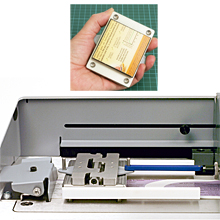
Sheet materials are produced in volume and supplied in bulk, in formats suitable for machine handling. Surface characteristics change through coating, inking, abrasion, folding, creasing and perforation. Coefficient of friction is significant to throughput and different at each change of use. Pulp and paper manufacture may utilise large rolls for web offset presses, large flat sheet-fed formats, down to digital presses, copiers and office printers. When considering supply of paper and board, customers specify COF requirements, in relation to machine and cross directions, and other attributes such as rub and blocking, if relevant. Testing based on standard ISO 15359 requires dedicated hardware to measure the forces and hence accurately calculate the static and kinetic friction. A horizontal plane method is used, with a sled dimensioned so as to exert a specified normal pressure on the contact surface. Importantly, there must be the capability to the set-down, dwell time and lift of the sled so as to protect the test pieces from surface damage and ensure that the sliding is also expressly controlled. This test covers the measurement of the static and kinetic coefficients of friction, the dynamic value being measured after three slides, and the calculation requires six valid results to average. Similar test standards do not stipulate an elevating mechanism, thus the ability also test without this feature adds versatility.
Mecmesin Systems: FPT-H1 Horizontal Friction Tester, ASTM 15359 Friction testing accessories
Standard: ISO 15359, Tappi T549
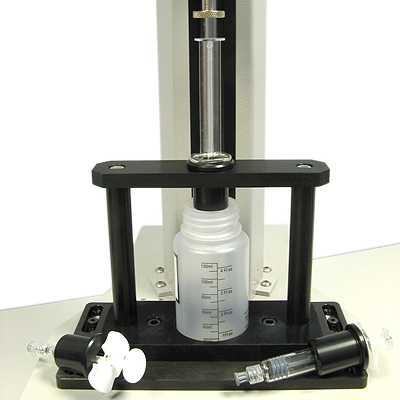
The majority of syringes are single use, disposable and manually operated. Consistency in plunger operation (smooth, and to a correct pressure) is essential, so quality testing requires representative gripping of barrel and plunger, and complete repeatability. Glide force testing can include both filled and empty syringes.
Mecmesin designs custom fittings for syringes of all styles and sizes to ensure a secure grip of both parts without distortion and correctly aligned. For filled syringes, these include fluid collection. Testing becomes both quick and repeatable.

Bard Ltd services its biopsy injector units, which are driven by a powerful spring, primed and triggered by finger pressure. To verify spring strength in units returned for servicing, they must be held in such a way that the trigger can be compressed as in use by hand.
Mecmesin devised a custom fixture featuring a quick clamp and stirrup pull bracket. Placing units for programmed testing is quick, easy and reliable, increasing throughput and ensuring complete repeatability.
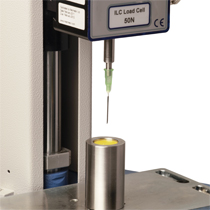
International standards (ASTM F2132, BS 7320) specify the puncture resistance of medical sharps containers. By using real sharps on samples taken from containers, on a programmable universal test stand, repeatable and reliable testing is possible.
Mecmesin designed and provided a Luer hub fitting extension to attach hypodermic needles of various designs to a loadcell, and a tubular sample holder to allow undistorted full penetration of the container wall sample.

Adhesion quality in post-production packaging labels is a more accurate test than on basic materials, due to deposits on surfaces and from operating environments. Post-production packaging, such as small metal containers, can, however, be awkward to hold during test.
Our client needed to perform a 90 degree peel test on labels applied to small tin lids. Mecmesin designed a dedicated custom grip to hold the tin without distortion, on a moving table peel jig. This ensured correct alignment every time for repeatable testing.

Our client manufactures liquid bulk carriers with two-part plastic valve closures. The collar is welded to a plastic bag, and the valve closure is fixed onto it by a compression joint. These joints are tested for the force to connect the two, and to pull them apart. The force required can be as much as 25 kN.
Mecmesin designed a collar-retaining plate and flexibly-linked valve attachment to secure both parts without damage or distortion, on a twin-column test stand. The two parts are then pulled apart axially and uniformly, whilst allowing for uneven detachment.

The shear strength of soils and sands can be an expensive thing to test, since the shear force applied is perpendicular to the main compressive force, and universal testers operate in one direction. Our East European client required an affordable solution for more occasional testing.
Mecmesin designed a compression cell attached to an AFTI digital force indicator, that could be inserted into a Mecmesin twin column test stand to apply the shear force. This provided an accurate and cost-effective solution.
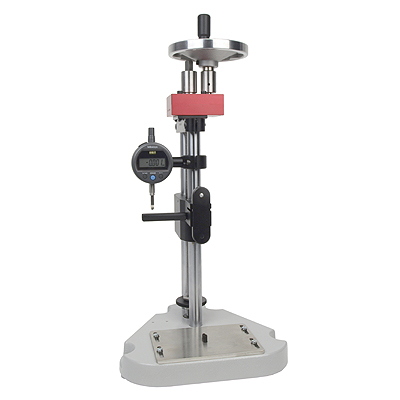
With a sensitive digital force gauge, such as the Mecmesin Advanced Force Gauge, a manually-operated test stand can be sufficient for small spring testing in compression or tension. For the lightest springs, very fine control is needed, and the standard gearing may be inadequate for fully-repeatable conditions.
With a sensitive digital force gauge, such as the Mecmesin Advanced Force Gauge, a manually-operated test stand can be sufficient for small spring testing in compression or tension. For the lightest springs, very fine control is needed, and the standard gearing may be inadequate for fully-repeatable conditions.

Gripping the base of a shaped glass bottle for a tensile test can present greater difficulties than for torque tests. Our client needed to pull a foil screw cap and tamper-evident sleeve from bottles of various sizes, without slipping at forces exceeding 1 kN. Barracuda grips are available for the cap, but the bottle required custom design.
Mecmesin designed adjustable V-jaws with rubber-edged finger grips that could interleave for smaller bottles yet be wide enough for larger ones. This provided the required grip under tension and axial alignment for the cap pull-off. Gripping samples securely becomes reliable and quick for improved throughput.

Propellants are avoided for many reasons in liquid and spray dispensers, with manual spring-loaded pumps used in their place. These are shaped for finger operation, and filled containers give a more reliable operational test. So how do you repeatedly test an awkward and messy pump dispenser?
Mecmesin met a client's needs with a custom designed bottle holder, and collection bin in stainless steel. This efficient solution ensured correct alignment, secure gripping under compression, and cleanliness.

Our client needed to test a number of small, lightweight springs under compression. To avoid buckling and sideways movement in the springs, a supporting spindle or spigot was required, to the dimensions of the springs under test.
Mecmesin designed and supplied compression probes with supporting pins, for operation on one of our regular MultiTest stands. These enabled rapid insertion and repeatable testing.
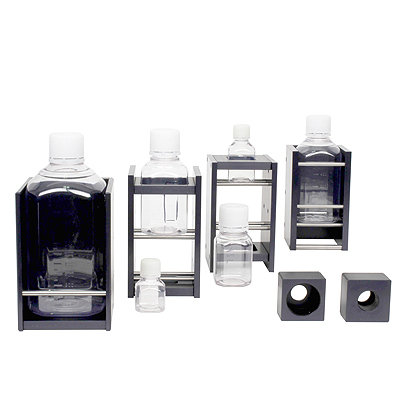
A pharmaceuticals company wanted to test the closure torque of a series of square-profile PET bottles. To minimise operator adjustment, they wanted to test all bottles at a constant height, using their Vortex-i torque tester.
Mecmesin responded by designing a set of nesting bottle holders along with a custom-moulded mandrel set. In this way each bottle could be axially aligned and presented at the right height under the torque head, for maximum test throughput.
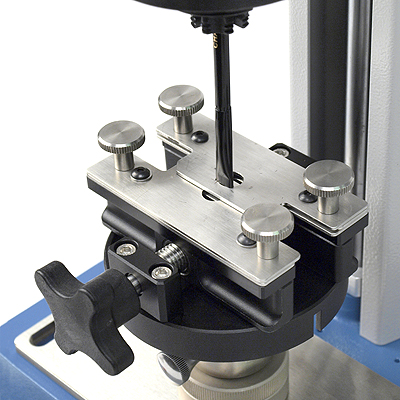
Our client manufactures cosmetics brushes for all applications, and so has a very diverse set for bristle integrity testing. Gripping the shaped handles and bristle tips in a repeatable way demanded more than a single standard vice grip.
Mecmesin designed a system of overlapping plates with cutouts for each brush head profile, to gather and trap the bristles uniformly in a vice action, axially aligned under the loadcell. Barracuda grips hold the handles securely for reliable and accurate repeat testing.

Our client was testing the release torque of 20 mm long plastic catheter caps with irregular features to aid finger gripping. The test is performed by hand with a digital torque sensor, but achieving maximum grip and quick insertion required customisation.
Mecmesin designed a multi-finger mandrel to ensure maximum contact and exact axial alignment. This improved the accuracy of the test through repeatability and cost savings through efficiency in use.

Semi-rigid vacuum-formed packaging, sealed by film or foil, is tested by the 135 degree peel method, to represent hand-pulling. The difficulty for testing is always in mechanical holding of the container. Our client was testing food packaging of a particular design and required a custom solution.
Mecmesin designed and provided a fixture to hold the flexible container in a matched recess by vacuum, at 45 degrees to the test stand column, and to peel from a corner. The film lid was gripped and linked to the crosshead by a chain link to achieve a secure and repeatable test. Vacuum fixtures also allow for rapid throughput of samples for quick and efficient testing.

In addition to top-load carton crush testing, the compressive strength across opposite edges can be an important measurement. This represents a typical shelf and stacking situation where damage can occur from falling. Holding a carton for this test without slippage requires custom fixtures to achieve the correct length and angle of applied compression.
Mecmesin has met these requirement for a number of clients, with custom-designed V-profile compression bars. These ensure the same angle of testing, along the length of the carton to be compressed, for perfectly repeatable testing.
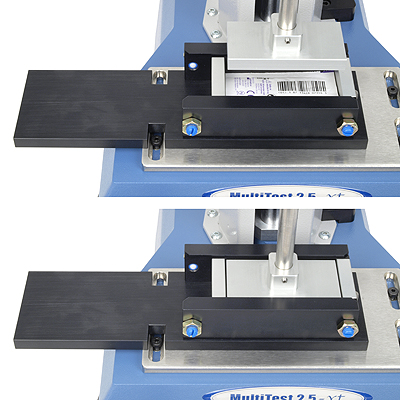
Plastic sachets with welded seams are frequently used for measured applications of liquids, creams and gels. A quick quality test for their integrity involves compression either to burst, or to resist a defined compressive force. This may require containment for spillage, but also for alignment. Our client was testing pharmaceutical sachets.
Mecmesin designed a sliding container, engaging under the test compression plate with ball catches for exact axial placement. This enabled quick exchange of test samples for maximum throughput and repeatability.

Our client manufactures glass syringes with compression-fit polycarbonate Luer lock adapters. Quality testing requires measurement of the torque required to rotate the adapter, to ensure it cannot come away under normal use of the Luer connection. The syringes come in various sizes, so a flexible range of grips was required.
Mecmesin met their needs with customised grips to hold the glass syringe barrel, and to grip the Luer adapter to turn it, with perfect axial alignment.
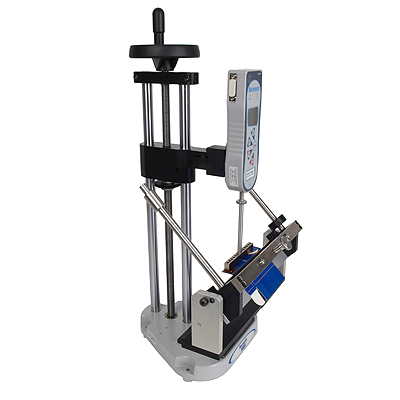
A packaging production company needed to test the maximum crease force in 90 degree folds in various materials. This required continuous accurate measurement by cantilever bend, through the folding movement.
Mecmesin designed a customised fixture to manually rotate the gripped card against a compression bar attached to one of our 100 N advanced digital force gauges. Clickstops at 45 and 90 degrees allowed the folding force to be recorded consistently at each angle for any material. Mounted on a manual test stand, this was a very cost-effective solution to their requirements.
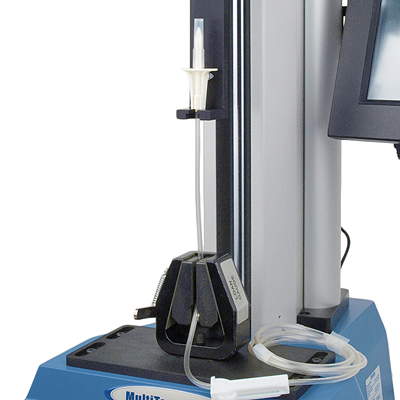
Pull-off tests require careful support of the separating parts to avoid distortions affecting the connection, or breakage due to grips. Several of our clients have needed to test the pull-away force of flexible intravenous tubing from connectors.
Mecmesin has designed fixtures to support the connectors in axial alignment with the gripped tube, for fully repeatable testing and rapid positioning of samples. A simple and cost-saving solution to a common, but specific, test situation.

Familiar with three-point bending? Our client needed to fold insulating film strip along its length rather than end to end, so the usual flexure fixtures were not appropriate. Instead they needed a blade and slot fixture with sufficient width.
Mecmesin designed and manufactured a slotted anvil with graduations for accurate sample placement, and a polished chrome plated blade, for consistent insertion and fully repeatable testing.
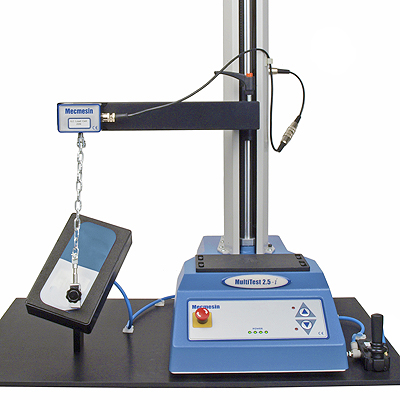
Our client needed to test the peel quality of film lids on semi-rigid pre-filled syringe packs. Inconsistent peeling can result in accidental content spillage, so the force required at a standardised 135 degrees must be measured for a complete opening action. Holding semi-rigid packaging so that it does not deform, requires a custom application for each pack design.
Mecmesin designed and manufactured a vacuum holder for an exact fit to the pack, positioned at the required angle under an extended tensile test arm. The lid was then peeled back with a grip on a flexible chain link. An added advantage of vacuum fixturing is the speed and accuracy of sample changing for maximum throughput and efficiency.
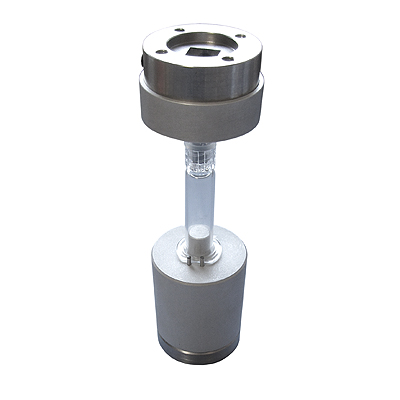
Luer lock test standards frequently involve the application of a simultaneous and prescribed axial force. Our client required fastening and removal torque of caps from from syringes without this. Precision measurement of the torque to fasten and remove the cap needed a simple custom solution.
Two parts, to grip the syringe base and to engage the Luer lock cap, were designed by Mecmesin, and allowed rapid exchange of samples for accurate and repeatable testing at maximum efficiency.
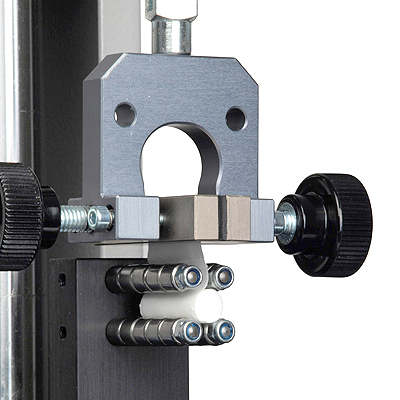
Floating roller peel jigs are available for security card lamination testing, but our client was testing the adhesion of the paper around cigarrette filters. To accommodate the small cylindrical shape required smaller and closer rollers, and a better sample loading design.
Mecmesin responded with customised fixtures for different sizes of filter, employing four roller bars instead of two. Loading samples for repeatable 90 degree peel testing is quick and easy, saving time and cost.

Torque testing of child-resistant bottle caps requires application of a simultaneous top load. Raising and lowering this repeatedly in a testing sequence is much easier, quicker and more secure when automated. Our client wanted to eliminate this manual effort by test operators.
Mecmesin supplied a pneumatic lift mechanism for the client's Vortex torque test stand, to lift the top-load weights and lower the torque head into place for each cap test. This makes batch testing quicker, more reliable, and less tiring for the operator to perform.

Test method standard BS ISO 4919 applies to the tuft withdrawal force of carpets. Our client tests artificial grass by the same method, and required custom fixtures for the coarser construction.
Mecmesin's solution was a quick-fit and release clamp plate for the matting, leaving an aperture for a forceps clamp suspended from the test loadcell. Testing is quick, easy and repeatable.
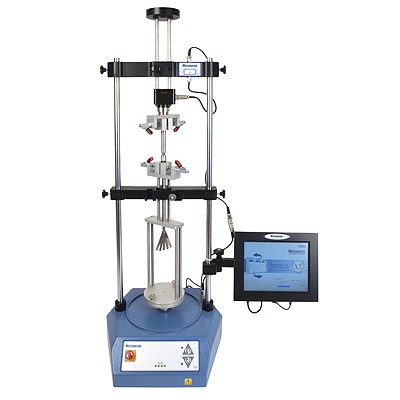
Endoscopic and laparoscopic surgical instruments are operated by axial and rotating adjustments in the handle, to perform precision movement in the head. One manufacturer asked us to provide test fixturing for the operating torque of a laparoscopic instrument in two controls, to splay and to flex the head.
Mecmesic adapted one of its Vortex-xt torque testers by extending its column height to accommodate the instrument length. By fixturing around the length, and gripping the twist controls in the handle, each manipulation could be independently tested for required torque to turn, and smoothness of operation.

Soldered, fused and welded parts in electrical and electronic assemblies can be difficult to grip in ways that mimic the forces applied when in use, because they are complex or asymmetric. Our client manufactures safety-critical alarms and asked us to provide custom fixtures for pull-out and push-out force testing.
Mecmesin designed an assemblage of fixturing parts for different components under test, in order to correctly align easily them every time. These included a sliding table, a chuck and a cylindrical sleeve holder.
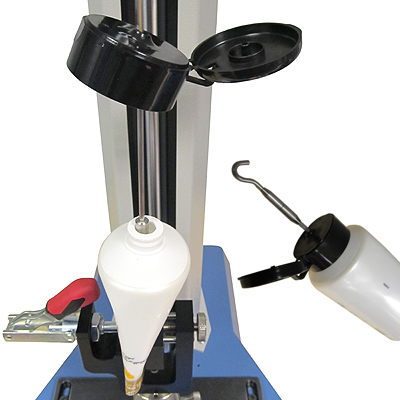
Many flip-caps on flat-sealed cosmetics tubes are not designed for consumer removal, and should not come off under normal use. Pulling them off to test the required force, without distortion through over-gripping, led our client to request a custom fixture.
Mecmesin provided a means of pulling the cap from the inside, a simple but effective solution for reliable and repeatable testing.
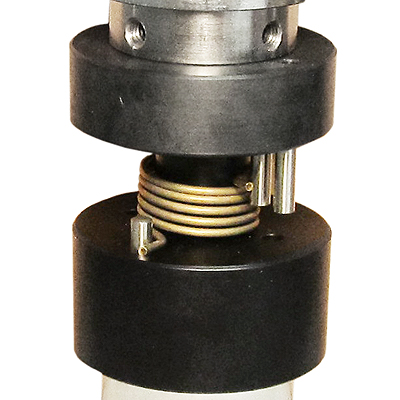
A manufacturer of torsion springs approached Mecmesin for a set of custom mandrels. Torsion springs require central core support, and turning pins to engage a wide variety of leg ends.
We regularly design custom torsion spring cores and mandrels to client specification, for operation on our Vortex and Helixa (precision) torque testers.
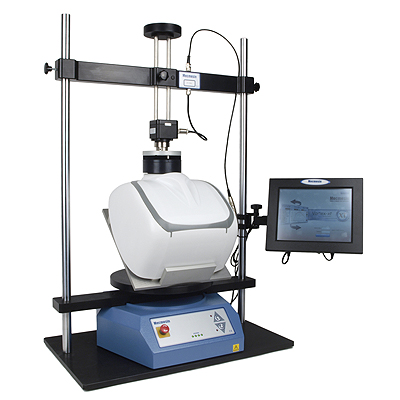
A manufacturer of hygienic disposal bins came to us with a nappy (diaper) disposal unit with a rotary intake mechanism. The bin was 30 cm wide and the opening at 45 degrees, making holding of the bin for proper axial rotation somewhat difficult.
Mecmesin designed a rotating platform at 45 degrees to rotate the bin about the axis of the rotating mechanism, but the width required an additional modification of our standard Vortex torque tester for increased column separation. The result was a tester for rapid and effective, repeatable testing to ensure consistent quality of the manufactured units.

Hypodermic needles can require comparative sharpness testing using synthetic skin, or for the purposes of syringe filling, penetration of closure elastomers such as silicone or neoprene. To do so conveniently, a membrane of uniform thickness elastomer, held under constant tension, can be repositioned for repeat penetration.
For a number of clients, Mecmesin has designed and manufactured custom fixtures for holding hypodermic needle assemblies, and for stretching elastomer sheeting over an aperture for penetration testing. Sharpness is not an absolute value, but the force required to penetrate a vial closure must be consistent, and different point bevels will yield different values. Importantly, during the test, the needle must not flex and the angle of presentation be precise.

Sometimes a client approaches us with a range of requirements for a number of their products. Using their universal testers for a variety of testing, they also need custom and versatile fixtures. Cosmetics packaging, for example, frequently combines design-led profiling with light handling, as in mascara tubes and brushes, attractively-curved lotion containers, and lipsticks. Some of these imply very light rotational torque, others maximum strength in lightweight design, for daily use.
Mecmesin custom grips assure axial alignment, secure holding and minimal deformation that might adversely influence test results and repeatability. In this example, compression, tensile strength and torsion strength were addressed in a suite of fixtures for a variety of popular products.

Push-fit electrical connectors must offer a firm but practical fit. Where vibration is a factor, they must especially not work free, but for maintenance they must be separable without being damaged or damaging other components. For repeatable testing of insertion and withdrawal forces, the connecting parts have to be held securely in alignment, without applying additional gripping forces in the connection.
Mecmesin designed custom fixtures for this client to hold the naked terminal parts and the spade connectors in a way that allowed for rapid test sample exchange and maximum throughput.


A major manufacturer of wire harnesses and connectors approached us for a cost-effective solution to strength testing cables of different diameters and welded joints, up to 1 kN. Standard cam grips to this rating proved too heavy and bulky.
Mecmesin designed narrow-profile lever cam grips for the required application, enabling rapid sample insertion and maximum throughput on a minimum requirement test system.

A fibre cable solutions provider needed a custom compression fixture to test plastic ducting strength. Mecmesin engineered a part to fit the inner profile to the required length
This is just one of many examples, where creating a fixture to fit a specific profile, or to insert into a manufactured part, solves all the problems of trawling catalogues of grips and fixtures for an approximate fit that may in the end yield inconsistent results.
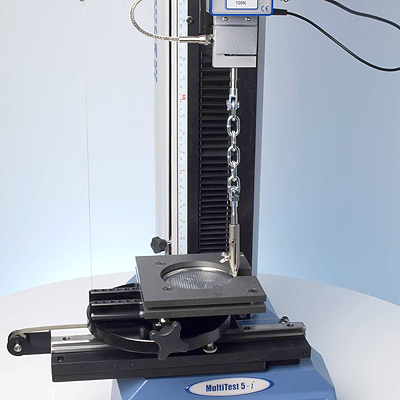
An international supplier of a powdered hot chocolate drink wanted to test several aspects of their plastic-capped, foil-sealed cardboard tube container. This included topload (column crush) of the cardboard, flip-off for the plastic cap and 90 degree peel testing of the metal rim and foil closure element, both removed and in situ.
To enable correct and secure gripping to an assisted peel table, Mecmesin designed a custom jig to hold either the tub base or the top rim closure. The client was then able to use their Mecmesin universal tester for all four tests, with quick and easy exchange of fixtures, and rapid throughput of samples for testing.y.

Some of the simplest applications may not seem so obvious when you face them. A string and tab on a tea bag? Commonly stapled in place, the test should be on the clipping of the string, not the tear strength of the bag itself.
For our client, Mecmesin devised the simple 'tea bag hook' to do just this. A small part, a simple test, but now done efficiently and consistently for daily quality assurance and brand protection.

It's straightforward: you need self-levelling compression plates but you can't find the appropriate size as standard. Our client was performing flat crush (FCT) and edge crush (ECT) tests on cardboard for cartons.
Mecmesin regularly designs fixtures to custom dimensions, and in this case supplied the precision parts to the client's specifications. Whether compression plates, tensile grip jaws, custom hooks or torque grips, our apllications engineers are always on hand to meet the need where off-the-shelf products aren't suitable.

A global supplier of medical equipment manufactures small dental abrasive disks. They needed to test the integrity of the riveted hub, for the torque at which it could begin to rotate in the disk. Clamping the abrasive disk whilst applying torque to the very small hub presented a particular challenge.
Mecmesin devised and supplied a custom fixture for rapid quality batch testing of different sizes of disk on a programmed Mecmesin Vortex torque tester. A clamp secured the outer disk, and a conical probe engaged the hub by friction. By rotating each test sample 90 degrees in one direction then 180 degree in the other, marked samples would clearly show rotation of the hub against the abrasive part.
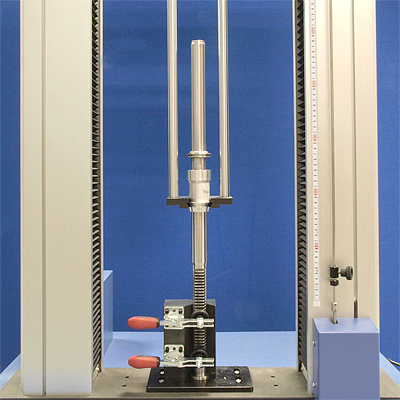
Sometimes the dimensions of a component make force testing difficult to achieve. Our client needed to test the sliding force of a bearing along a steering rack rod end, requiring accurate axial alignment of the bearing grip with that holding the rack end of the rod. In this way they could measure manufacturing quality of the assembly. The test required both height capacity of a test stand, and custom fixtures.
Mecmesin supplied a twin-column universal tester and designed the required fixtures for both push and pull testing of the bearing. Coupled with Emperor data acquisition and analysis software, engineers were then able to measure the frictional forces and smoothness of action over distance of travel, in a reliable and repeatable way.

Our client provides prefilled syringes, closed with Luer-lock caps. The release torque of these is quality controlled for consistency, requiring precise measurement and total repeatability for any syringe tested. For efficiency of throughput, the fixture was requested to be single-handed operation and for syringes of different sizes.
At Mecmesin we devised a simple but precise drop-on mandrel for the cap, and an open-sided column to receive the syringe, with flanges for different lengths. Mounted on a Vortex-i torque tester, this povided a rapid and efficient throughput system for quality assessment.
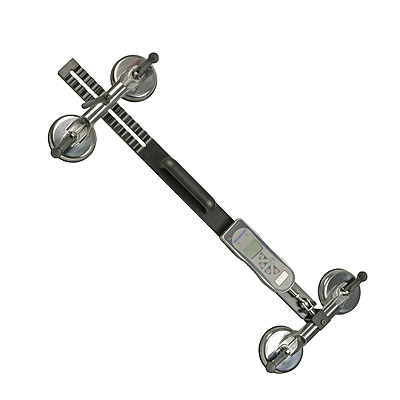
A UK train operator needed a method of testing the obstacle detection sensitivity of carriage sliding doors. They already had a method for adjustment, but needed to measure the forces acting between stalled-opening and stalled-closing door leaves that would not interfere with their test brackets.
At Mecmesin we devised a sliding bracket to house a digital Advanced Force Gauge, attached by four quick-release suction cups. Attached across the open-door gap, the force required to open and restall the doors could be measured, allowing readjustment and remeasurement.
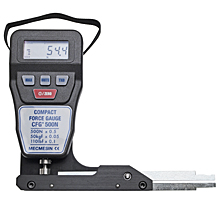
An aerospace engineering client needed to measure the pinch force between welding electrodes. Clearly something accurate, small and portable was required, operable single-handed, and affordable to be deployed around the fabrication shop.
Mecmesin designed a cantilever to match the electrode gap, which fitted to our CFG+ digital force gauge. Insertion between the weld tips allowed rapid readings of peak force in order to adjust and maintain, with minimum disruption.

Our client in vehicular upholsery needed to test the peel adhesion strength of leather bonded to metal. A 90 degree peel is straightforward enough, but gripping the metal and leather test sample required a custom vice, mounted on a standard sliding table.
Mecmesin supplied the complete fixturing, including the design and manufacture of a vice to grip the metal substrate from which the adhered leather was to be peeled. Mounting test samples was then very quick and precise, allowing rapid and repeatable testing.
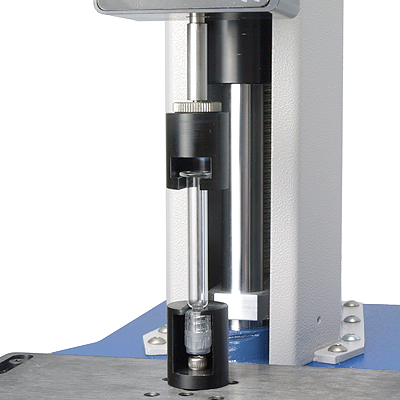
Polycarbonate Luer locks are push-fitted to glass syringe nozzles with a friction fit. Quality assurance demands that they cannot come free under normal use. They can also be tested for removal torque, but our client wanted a direct pull-off test. This required custom grips for both the glass syringe and the plastic lock so that the one would not break and other not deform.
Mecmesin designed and supplied the fixture pair, allowing rapid placement of samples for efficient throughput. The test became a simple, reliable and repeatable exercise.
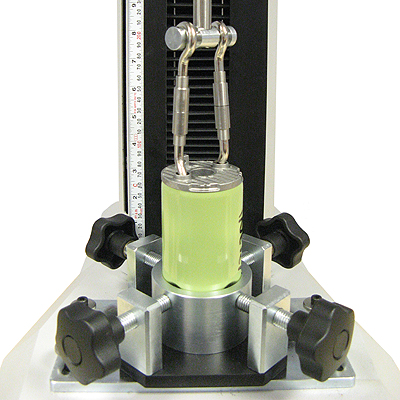
A manufacturer of smoke grenades required a means of testing the cap pull-off strength, especially gripping the smooth metal cylinder for up to 5 kN of pulling force. An annular clamp would be needed with penetrating pins to hold the cannister, and in alignment with the applied load.
A four-way grip was designed and manufactured by Mecmesin engineers, with pins penetrating the canister base. This provided a secure and symmetrical grip, whilst pulling the rigid cap off with hooks applied to the two cap holes to measure the peak force applied.

A manufacturer of filtration products needed to test the extraction force of a respiratory filter from an inline holder. A standard wedge grip could pull the filter, but the inline unit needed to be correctly aligned each time for the test.
Mecmesin designed a fixture profiled to the plastic holder, allowing rapid sample insertion and setup for an accurate and repeatable test.

Adlens manufacture adaptive spectacle lenses, where the optical power is adjusted by a side dial which is then removed. Among other tests, they needed to measure the running torque and rotation to destruction of the dials, to test for smooth running and consistency. An essential element in such low-torque testing is concentric alignment for detection of imperfections.
A Vortex-i torque tester with Emperor software was fitted with a custom fixture to support the lens piece, whilst a custom-moulded mandrel engaged the adjustment dial. The fixture pair enabled adjustment for accurate alignment, repeatable testing and detailed examination of the dial rotation quality.
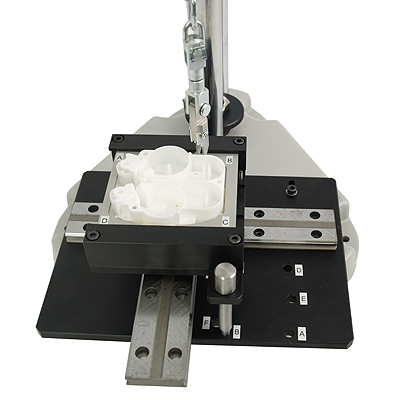
Plastic injection-moulded subassemblies can be clipped or welded, and the integrity of the whole must be tested at several points. However, their shape can make them very difficult to hold, and places to grip for pulling hard to identify. Our client needed a complete custom fixturing solution.
Mecmesin engineers designed profiled nests and retaining plates, an X-Y table for positioning the test sample, and a range of hooks to pass through apertures and engage edges in the assembly. This enabled a defined sequence of pull-off tests to be made consistently across a number of samples for batch testing.

A manufacturer of flat-supplied cardboard beverage bottle carriers, wanted to quality test the fold-out force for a variety of designs. Ideally the faces needed to be pulled evenly apart.
Mecmesin designed a base plate with locating flanges for each design to be tested. The underside of the flattened pack was held in place by vacuum pumped suction, and the upper pulled up by a cluster of suction cups. Test samples could then be laid quickly and the vacuum engaged, then the pulling fixture similarly lowered and suction engaged on the upper surface. Accurate measurement of the pulling force to open each box out could then be made.

British Gypsum carry out repetitive penetration tests to accurately assess the performance and durability of their products. The test, into the edge of plasterboard samples, is repeated sequentially along the board at fixed positions.
Mecmesin supplied a custom automated system, capable of up to 50 sequential edge penetrations per board test sample. The pre-programmed system provides complete consistency and control in penetration separation (indexing), penetration depth, and penetration force, capturing detailed data for full analysis.

Plastic bottle caps and T-corks have individual profiles for finger gripping, and the best way to torque-test their performance is by providing an exact machine grip at as many points as possible. Many well-known brands and manufacturers come to us for custom-profiled mandrels to use on their torque testers.
A custom mandrel is much quicker to place and release than a screw-fit clamp, and by precise positioning offers true repeatability in testing of bridge torque, removal torque and running torque.
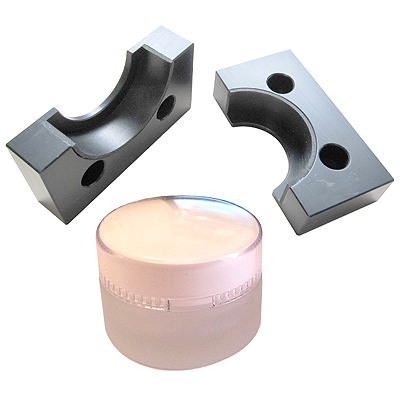
Smooth twist caps on bottles and jars require an adequate and symmetrical grip without distortion. For any particular product line and size, a customised grip will always perform best and produce the most reliable results.
At Mecmesin we regularly design and manufacture mandrels for specific closures, and one approach is the convenient split mandrel with a simple screw clamp, for quick application and release. Items such as cosmetics containers can especially have designs that are easy for the hand, but difficult for machine holding, so a modified or custom grip may also be needed for the container. Again, our custom engineering service can provide a suitable fixture design for you.

Child Resistant Closures (CRC) require axial force and simultaneous torque, for testing removal torque, or reverse-ratchet torque. Mecmesin torque testers, such as the Vortex and Helixa, will do this to international industry standards and regulation, but the most reliable results will be obtained by using a custom-profiled mandrel for the cap.
We regularly design and provide custom mandrels, especially to the pharmaceuticals packaging sector. Contact us with your requirements for a quick response towards improved testing.

A global chemical company’s R&D laboratory required an improved testing method for the evaluation of adhesive formulations. Internal quality standards necessitated the measurement of tack in viscous adhesive pastes–with the ability to make comparative analyses between multiple samples in a single batch. The procedure also needed to be performed with the glue being sustained at an elevated temperature to simulate real-world environmental conditions. Mecmesin worked with the customer to design a fixture system with six identical circular cross-section sample containment recesses, with integrated heating platen rated to a maximum temperature of 150° C (and able to sustain a constant 120° C for the test itself). The fully programmable computer-controlled UTM is able to load-hold at a constant compressive force for a set time when applying the probe surface to the specimen substrate, then retract at constant speed after the specified dwell time in the adhesive material. This action is repeated number of times to gauge the evolution of the tackiness over multiple contacts. The software analyses the data and performs calculations to return the peak force information for each sample, indicating the tensile strength of the formulation under pull-apart loading. The results are available for each individual specimen, its repetitions and the averaged value for the complete set. This solution provides a consistent methodology for the chemistry lab to implement in back-to-back adhesion testing of products for tack, texture and other attributes which determine ease of application, handling, longevity and ultimate adhesion performance.
Mecmesin Systems: MultiTest computer-controlled force test system,

The tensile testing of yarns may involve several specific procedures, intended to evaluate the performance of individual yarns and quantify comparative evaluation between alternative materials or suppliers. Accurate testing of material behaviour or ultimate failure strength can be achieved with a motorised universal tester, appropriate grips and a test program design to apply the relevant standard. Typical procedures apply axial loading to the test sample—either individual threads, or multi-filament if applicable to the intended usage. A motor-driven test stand ensures constant speed of loading for optimum repeatability; suitable for any test standard for textile and fabric strength, e.g. ASTM D5034 – grab test procedures for elongation and break strength. Measurement of peak force at failure and elongation at break are important properties of the textile, as are further industry-standard calculations such as breaking tenacity (force divided by linear density, or denier) and toughness (the energy absorbed over the deformation). Accuracy of the measured values is highly dependent upon proper fixturing of the sample to eliminate breakage at the point of gripping. Mecmesin’s selection of bollard/roller and filament grips provide reliable breakage testing due to smooth sample contact surfaces and ball socket joints to ensure consistent axial alignment.
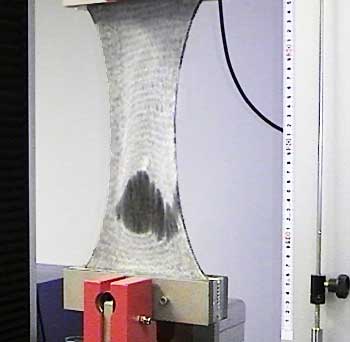
Geotextiles undergo a range of forces in their intended applications and determination of their suitability for in-service conditions involves a number of test types. The variety of materials utilised—both synthetic polymer and natural—and method and construction—woven, knitted or non-woven—means that quality testing requires consideration of the sample gripping, manner of deformation and loading capacity. Mecmesin has a range of force testing systems from mid-capacity single column configurations up to 50 kN twin column UTMs. A geotextile fabric may undergo forces which could stretch, tear, puncture or penetrate the membrane and an appropriate replication of the relevant loading is essential to quantify the performance of the textile in its environment. Typical international standards targeting these test types include: ASTM D4533, trapezoid tearing strength of geotextiles; ASTM D6241, static puncture strength of geotextiles and geotextile-related products; ASTM D4632, grab breaking load and elongation of geotextiles.
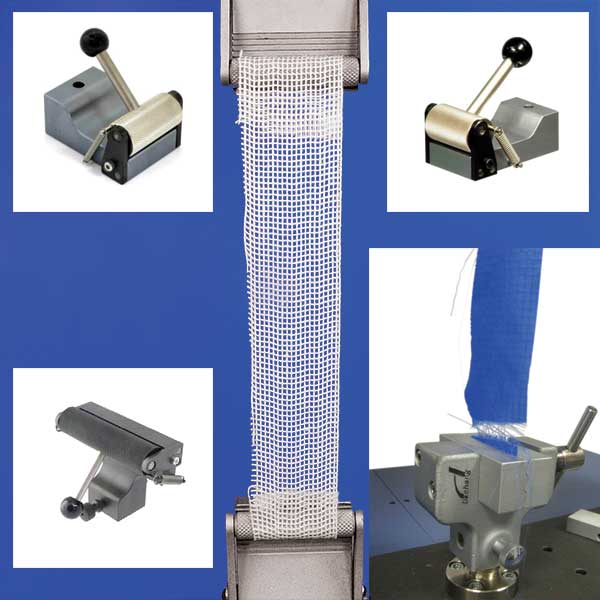
Medical textiles reach their end user in both yarn or fabric forms, necessitating a specific test in order to evaluate the quality of the product for its intended purpose. The materials themselves must meet stringent requirements over and above their physical properties such and strength and flexibility—relating to hygiene and resistance to infection, or the need to be non-reactive in the case of implantable textiles. Individual yarns (for example suture thread) should be tested for ultimate tensile strength, to minimise uncontrolled breakage, but facilitate breakage or cutting when required by the surgeon. Motorised test stands fitted with roller or bollard grips ensure reliable measurement of truly representative sample breakage, away from fixture clamping. Clothing and other protective garments must be evaluated for tear, peel and puncture/penetration resistance as well as ultimate strength and elongation properties. Mecmesin’s universal testers and dedicated peel and tear test systems can accurately measure the performance of medical fabrics to international standards against Delft, tongue, single rip (trouser), trapezoidal and Graves tear procedures. Computer controlled systems enable specific in-house tests to also be performed. Some fabrics may also require a degree of penetration resistance which is easily evaluated by our UTM systems. Patient dressings must be flexible enough to cover any part of the body and also protect and support many types of injury, thus the measurement of elongation and ultimate tensile strength enables the manufacturer to quantify the performance of the textile completely.

A consumer packaging manufacturer may produce a variety of containers for the cosmetics industry, which in addition to their functional requirement, may have strong design influences. The range of shapes and sizes that result need a versatile quality testing solution to evaluation the effectiveness in sealing plus ease of opening for the container caps. An adjustable clamp, able to securely grip different bottles and jars (possibly made from glass) is needed to measure the torque required to release the lid of the jar. A simple, light and portable digital desktop instrument, measuring the peak value as the lid is released by hand can quickly assess the quality of the screw top closure. For flexible plastic containers, with plastic caps, there could be a danger of the lid being pulled off. A tensile tester with appropriate grips and fixtures will provide repeatable pull-off resistance appraisal.
Mecmesin Systems: MultiTest motorised test system, CAPTEST
Case Study: Cosmetic Packaging Pull-Off Test

Consumer packaging products where a flexible thin material (such as plastic or aluminium foil) forms a peelable lid, should undergo peel testing. The adhesive bond is formed around a mating surface at the perimeter as seen in the seams and seals of retort pouches or pots for the food industry and medical device packages. The test program must maintain the 90 degree pull angle, with the container remaining horizontal whilst travelling laterally via moving table jig, achieved by mechanically driving the table from the vertical motion of the test stand crosshead. Consideration should be given to securing the container and a bespoke moulded vacuum fixture is recommended, particularly if the quality standards stipulate that deformation should be minimised. Suitable flat-jawed grips are needed to securely grasp the lid throughout its vertical movement.
Mecmesin Systems: MultiTest motorised test system
Case Study: Retort Pouch
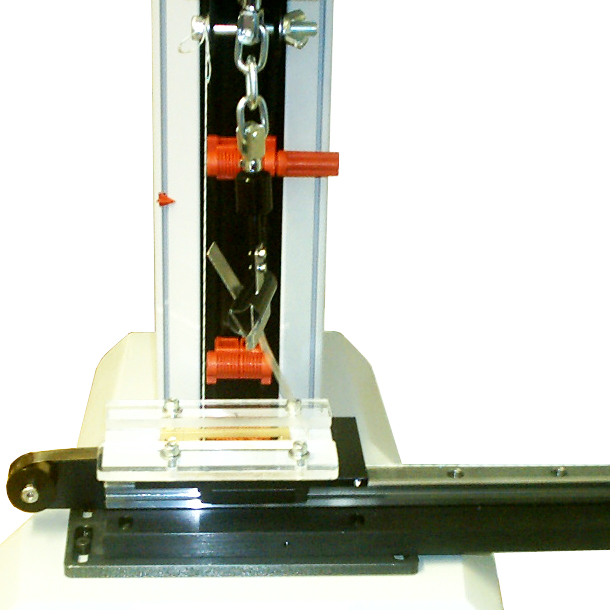
Products utilising thin films or foils to form a coating or layer require peel testing to evaluate the integrity of the adhesive bonding of the coating. Components such as flexible displays comprise layers of thin films and substrates. A 90 degree peel test can be performed to quantify the adhesive properties of samples to analyse the effectiveness of different compositions in a manufacturing, educational, or research and development environment. The test equipment must maintain the 90 degree pull angle, with the substrate remaining horizontal, achieved by means of an assisted peel table fixture. Flat jawed wedge or vice grips are needed to securely hold the thin film throughout its vertical movement.
Mecmesin Systems: MultiTest motorised test system
Case Study: Thin Film Peel
Video: Peel Test on a Foil-Sealed Wine Glass
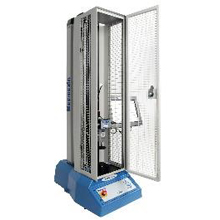
Coil springs as used in the transport industry or other general engineering applications may be elements of safety critical components, particularly in public transport (suspension system) or aviation (brake unit) implementations. To evaluate the performance of helical springs under load, the compression test equipment must ensure that the axis of compression remains constant. A coil spring will tend to lean and become out of square under load. Self-levelling compression plates and fixtures custom-designed to constrain and locate the spring must be used. Safety guarding should be a feature of the test system for large powerful springs.
Mecmesin Systems: MultiTest computer-controlled and console operated compression testers
Case Studies: Aircraft brake unit spring testing, railcar spring testing, bespoke spring design and manufacture
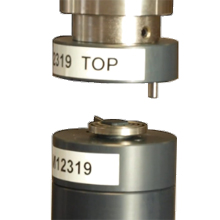
The helical torsion spring comes in a wide variety of sizes and finds use in a diverse range of industries. Spring loaded componentry in home and consumer goods: clothes pegs, clips and old-fashioned mousetraps; small doors and flaps on cameras or hi-fi equipment; large doors and closures such as those on garages or gates and in transport applications like vehicle luggage compartments. Calibrating the torque to turn (running torque) of the torsion spring is required to achieve the desired levels of effort for the user to open/close the component and provide the optimum levels of resistance or snap. The ability to test a range of products requires a set of custom fixtures to match the spring design, for example spiral. A lower rod-shaped mandrel holds the spring and the upper fixture incorporates a drive peg – directly connected to the torque cell – which locates into the outer arm of the spring to load and unload the sample. Computer control with a suite of test programs can rotate the spring to a pre-defined angle and collect the torque and rotational displacement data continuously. The software ensures repeatable testing of clockwise or anti-clockwise turn (approaching the design load point from below and above, then averaging, minimises the effect of friction and hysteresis on the results) and can guard against permanent set in the spring material. The requirement to meet specific torque range limits – within the linear response range of the spring - can also trigger immediate PASS/FAIL indication as the results are recorded and displayed.
Mecmesin Systems: Vortex computer-controlled torque testers, Emperor™ (Torque)
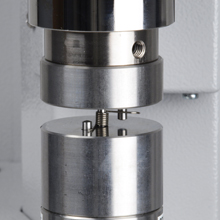
The helical torsion spring comes in a wide range of designs and varying sizes to cover almost every engineering application. Despite being termed ‘torsion’, the spring itself is subjected to a bending stress when the ends rotate about its central axis, driven by the components attached to either arm. The elements which are required to rotate in service depend upon the spring’s stiffness rating in order to be fit for purpose and also exhibit the correct level of resistance for ease of operation and quality feel. The smallest examples, used in precision applications, need to employ a test system which can not only ensure that the spring’s axis remains aligned to within tight tolerances but that can accurately measure the resulting very light torque values. In these implementations, the frictional forces experienced by the coils may have significance. A spring design with pitch between the coils, rather than close-wound, will counter this issue and allow for even lighter torque to turn efforts, increasing the need for a torque test system capable of measuring these values. Exacting alignment of the fixture (hence spring) and torque cell axes for concentricity should be a capability of the test stand to guarantee the most accurate data.
Mecmesin Systems: Vortex computer-controlled torque testers, Emperor™ (Torque)

Measuring the torque required to wind sunroofs and manually operated windows in vehicles requires portability when the requirement is to evaluate in-situ. Such a test system could be implemented on the production line to provide quality assurance at the point of assembly. Measuring the starting (torque to turn) and running torque in both directions can be achieved with a digital torque indicator connected to a rotary torque transducer mounted on a standard cordless screwdriver. With the addition of a custom designed bracket, the bespoke system is self-contained and convenient to use on multiple locations round the vehicle.
Mecmesin Systems: Advanced force and torque indicator
Case Study: Window and sunroof torque

In order to meet internal testing requirements of a major automotive manufacturer, Mecmesin designed a system to measure the torque to turn input to a vehicle steering system. A custom-designed rig, fitted over, and attached to, the standard vehicle steering wheel, enabled the vehicle to be driven as normal. The Advanced force and Torque Indicator (AFTI) gauge displayed the torque value on the display in front of the driver. This system allowed the steering column running torque to be continuously measured in-situ, as part as an overall development process in steering system design, manufacturing and testing. The data capture and communication capabilities of the portable AFTI enable measurements to be taken in restricted spaces and more sophisticated analysis to be performed subsequently if required.
Mecmesin Systems: AFTI Advanced Force and Torque Indicator, Customised applications service
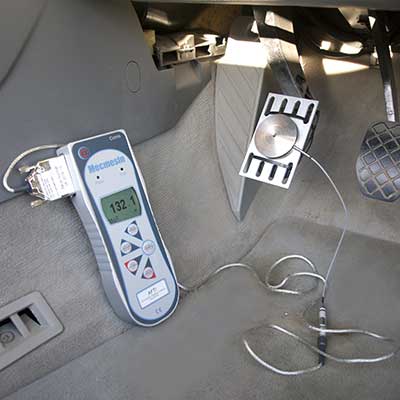
The effective actuation of fundamental controls is essential for safe operation of any vehicle. Foot pedals controlling the acceleration, braking and the clutch for manual gear changing, must be able to be depressed with ease by a complete anthropomorphic data range of driver/operator. Measurement of the pedal actuation effort is vital to performance testing of these systems, in terms of reliable operation; the input force must trigger the componentry to apply the brakes, move the throttle linkage or disengage the clutch. Additionally, pedal force testing enables useful evaluation of pedal “feel”, which provides feedback to the user regarding the need to confidently apply more or less actuation force and also conveys information about product quality. Mecmesin has supplied pedal force sensor systems to automotive OEM industry suppliers and testing services, enabling the measurement and data acquisition of these pedal force characteristics to guarantee performance against quality standards. The compact smart load button cell and portable AFTI gauge can be use in confined operating spaces whilst the first peak and maximum recorded data can be stored in the gauge prior to export and further analysis.
Mecmesin Systems: AFTI Advanced Force and Torque Indicator, Customised applications service

Automotive customers demand reliability and quality from their purchases; an owner’s vehicle often an extension of their personality. Brand loyalty depends on many interactions between the user and all elements of their vehicles. Experiencing the tactile feel of controls, switches and buttons are the most common instances where an owner judges the quality level of the product. Ease of application, positive engagement and consistent performance over the lifetime of the component are essential design criteria. One user-centric control is the remote locking key / key fob. Actuation of the button must be simple to perform, and the control give a clear indication that the inner switch has been activated. The force to depress the button must also be high enough to avoid accidentally being activated to eliminate the risk of leaving the vehicle unlocked. Using a light capacity intelligent loadcell and a narrow diameter compression probe, Mecmesin enabled the actuation force of the small, finger-tip sized buttons to be compression tested. Tests can be run for adherence to design specification for pass/fail values or repeated cyclic testing for durability.
Mecmesin Systems: Force testing systems range

Vehicle cockpit controls must operate with ease, positive engagement and with a tactility that conveys quality and confidence. Many controls are multi-functional and incorporate mechanisms that move both axially and rotationally. Lighting and wiper stalks rotate about the steering wheel axis to switch on or off and also about their own axis to control additional adjustable settings or auxiliary functions. Mecmesin's range of torque testing products and extensive range of versatile grips allow these torque values to be measured accurately and repeatably. Important attributes may comprise the initial breakaway torque to initiate the rotational movement and the subsequent running torque to complete the actuation. Manual torque testers easily enable a user to operate the control as they would in the vehicle to quantify the human perception. Our motor driven software-controlled systems can be programmed to run the exact same test again and again for QA testing against standard values.
Mecmesin Systems: Motorised torque testing systems, Manually operated digital torque testers
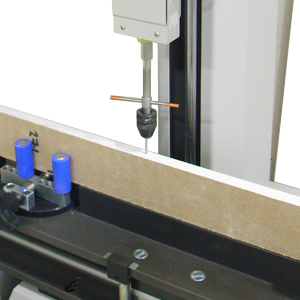
Construction materials may take a wide variety of shapes and sizes, as well as being fabricated from an assortment of materials. The performance of these structural products in service is important and plasterboard’s composite layering of paper and gypsum allows modification to its structure to provide desirable qualities in use, for example noise insulation. Penetration resistance testing is important in these lightweight materials to ensure durability – the maximum force required to reach a specific penetration depth. A large sample may require testing at specific intervals along its length to evaluate the consistency of the construction and the associated data: penetration separation (indexing), penetration depth and penetration force analysed accordingly. A custom fixture and a bespoke automated system to enable complete control of the process will facilitate this type of quality testing on these bulky panels.
Mecmesin Systems: Automated test systems
Case Study: Plasterboard penetration testing
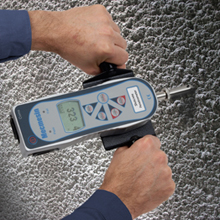
Verification of consistency is vital in the initial stages of the concrete curing process in order to ensure maximum compressive strength. The measurement of compressive strength development over time provides verification against the J1, J2 and J3 classes of sprayed concrete. During the early phases, two test methods are applicable, with multiple needle penetration tests being used in the initial stage (typically the first 3 hours or so after spray application) where the calculated strength falls below 1.5 MPa. The method consists of several iterations of ten resistive penetration force readings (to 15 mm depth) taken in rapid succession – under 1 minute – which are averaged to obtain one value in Newton. Typically 5 or 6 iterations would be performed within the initial time frame. A conversion curve (or formula) is then used to find the equivalent compressive strength value in MPa. The curve itself depends upon the mix design, influenced by the size of aggregate, for example. The results are then plotted on a time against compressive strength graph. The standard defines the specific dimensions of the penetration needle as 3mm diameter with a 60 degree taper angle. A digital penetrometer, with handles, oriented display and the ability to store peak force readings provide a convenient, robust and portable solution for use on-site.
Mecmesin Systems: Shotcrete Penetrometer
Standards: BS EN 14488-2, ISO 14488
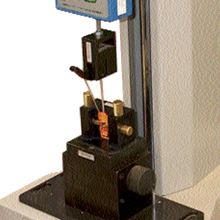
Automotive safety-critical systems, such as welds in vehicle airbag connectors, require rigorous testing for zero defects. Pull-off and pull-out testing to destruction at a constant and consistent speed and with complete repeatability enables maximum conformity to quality control standards. To enable the testing to be performed by production staff on the factory floor, special customised quick-release fixtures, enabling batches of test samples to be changed very simply for maximum throughput, enhance the suitability of this solution for automotive assembly applications. Data output is easily achieved from digital gauges for transmission to the organisation’s Statistical Process Control (SPC) software.
Mecmesin Systems: MultiTest motorised test system, digital force gauge
Case Study: Safety-critical welds in vehicle airbags
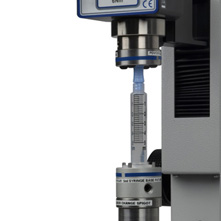 Luer fitting slip, running torque and force testing
Luer fitting slip, running torque and force testingLuer lock and Luer slip fittings commonly attach hypodermic needle hubs to syringes and other fluid transfer medical devices or laboratory instruments to provide leak-free connections via a 6 percent taper at the joint. Both the threaded and friction types must require a high enough torque not to disassemble in operation and still maintain the hermetic seal, whilst still allowing easy and quick engagement/disengagement of the connected system. Breakaway and running torque tests are the means by which these performance criteria are evaluated. The quality assurance testing of mass-produced medical Luer slip and lock fittings demands precise control of concentricity at extreme low torques which is facilitated by the use of specific fixtures for accuracy and repeatability – industry standards often stipulating that the sample be assembled to a particular precision steel reference fitting. The Ease of Assembly test requires the addition of an axial force in conjunction with the rotational force, and a testing system which allows the precise application of this force is essential. The Unscrewing Torque test ensures that the Luer connection can be unscrewed with minimum trauma to the patient.
Mecmesin Systems: Helixa precision torque test systems
 Dosage pen dosage dial torque testing
Dosage pen dosage dial torque testingThe medical industry demands that the administration of dosage requires the correct dosage to be injected for the individual patient. The rotational dial of an dosage pen’s dosage regulator must turn easily but positively enough to allow the correct number of dosage units to be accurately delivered from the disposable multiple use cartridge. In order to test the light breakaway and running torque values required to operate the dosage dial, it is essential to eliminate friction and position the sample with absolute concentricity. A torque tester that features a counterbalance to negate the axial force of the grip and torque cell in addition to precise adjustability of the alignment between the torque cell and the spindle is required. Fixturing for the sample should also ensure that it is maintained in an upright position.
Mecmesin Systems: Helixa precision torque test systems
 Biopsy needle injector gun spring strength
Biopsy needle injector gun spring strengthA biopsy stylet and cannula injector gun is a medical appliance for quickly and reliably extracting a tissue biopsy sample. A prime component in this hand-held device is a powerful spring, which is compressed by a single finger trigger action. The tolerances for the compressive spring rate are very specific - low enough to allow a user to operate the mechanism and cock the gun, yet high enough to perform a full and effective insertion and withdrawal of the needle. Stringent compressive strength testing standards require multiple tests on each injector gun to ensure repeatability and reproducibility at the quality control stage of production or refurbishment. A bespoke fixture to simulate the finger and apply the trigger pressure, whilst holding the medical device securely may be needed.
Mecmesin Systems: MultiTest motorised test system
Case Study: Biopsy injector spring strength
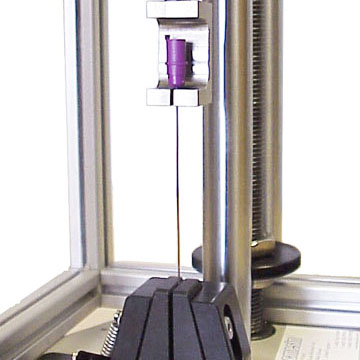 Needle and lancet pull-out testing
Needle and lancet pull-out testingSurgical needles and lancets may be located in their hub or ferrule by a variety of methods, including bonding, moulding, welding, mechanical interlocking, and sealing. The retention, or pull-off strength of the assembly method must be sufficiently high that the peak frictional force during usage does not cause disassembly or seal failure resulting in the needle remaining in the patient. To test the pull-off/pull-out performance, the test system is normally fitted with a suitable mounting block, to support the hub in such a way as to leave the needle tip exposed vertically. In the case of smaller needles and lancets, a lever-operated pin vice may be used to grasp the tip, and for larger gauge needles, a wedge grip may be required to hold the sample. An axial tensile load is applied at a constant rate, until the needle is completely dislodged from the hub. For safety considerations, the test system should be contained in a protective enclosure to provide protection from the fracture and breakage of sharp objects.
Mecmesin Systems: MultiTest motorised test system, digital force gauges, manual test stands
Case Studies: Lancet needle retention test, needle pull-out test
White Paper: An Examination Of Needle And Syringe Force Testing
 Car door closure force
Car door closure forceThe effort required to open and to close car doors is variable throughout their travel, and is optimised for the anticipated strength of a wide range of users. The tensile force measurement in situ is difficult due to the typical confines of a vehicle interior. With such a wide variety of designs of interior cabins in the automotive sector, a portable and customised system may be needed to measure and store the changing forces during opening and closing, for a range of vehicles. A force gauge and loadcell for allowing storage of detailed and accurate measurements for subsequent analysis would need to be connected through a bespoke system design, connected to the interior arm-rest, which will facilitate the application of a preloading tension.
Mecmesin Systems: Advanced Force and Torque Indicator, S-Beam loadcells
Case Studies: Car Door Closing Energy Tester
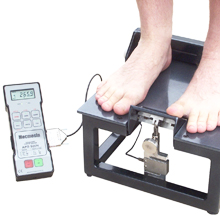 Physiological measurement of joint exertion force
Physiological measurement of joint exertion forceMedical and veterinary facilities can utilise force testing equipment to evaluate the capabilities of human (or animal) subjects for any number of research projects. One purpose may be for the collection of data as input to the design of occupational health and safety products or equipment. In the specific example of the range of joint strength in patients' big toe (the metatarsophalangeal joint), the angle of the toe may also be significant. A bespoke testing platform incorporating an intelligent loadcell, would be required to allow the positioning of the foot consistently and hold the toe at measurable, variable angles. A portable digital gauge could be easily employed to capture the data from individual patients over time, and the compressive strength results analysed and used for research or educational purposes.
Mecmesin Systems: Advanced Force Gauge, S-Beam loadcells
Case Study: Physiological Measurement of Joint Strength
 Glued cardboard packaging tensile strength
Glued cardboard packaging tensile strengthThe use of paper and cardboard consumer packaging has many advantages in terms of lightness, cost and recycling possibilities. A supplier of beverage carriers, would need to ensure that the production processes are able to manufacture these containers to a quality level which will maintain their shape and functionality whilst in service. Typically, cardboard beverage carriers are manufactured flat and opened out whilst moving along the production line. During the process, the glue must set, excess glue must not create unwanted adhesions, and the unfolding must not detach or weaken glued seams. Quality assurance of the carrier's integrity to the required point of glue setting, requires tensile testing at forces applied by both production machinery and manual end users. To test the opening of the cardboard carrier it may be required to design a bespoke fixture to handle the lightweight material in the same manner as an end-user application. In this example, the automated test stand employs a vacuum fixture to lift one side of the container to a maximum load while the opposite side is clamped firmly in position.
Mecmesin Systems: MultiTest motorised test system
Case Study: Glued cardboard packaging integrity
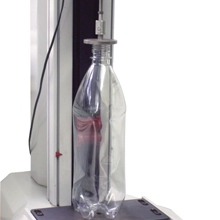 Top-load testing PET bottles and containers
Top-load testing PET bottles and containersA consumer packaging manufacturer supplying the leading brands in diverse markets must ensure that their product testing meets the demands of all organisations in the supply chain. For a producer of PET (Polyethylene terephthalate) plastic bottles, part of the total quality control must ensure the axial strength of bottles is continuously monitored (see this article: why test top-load?). The industry demands a responsible approach to minimising raw materials for both cost and environmental reasons, so strength remains critical for the containers, from filling and capping to transport and storage. Top-load (column) crush test systems can be employed at the production line (with a console-controlled touch screen for quick access to relevant test programs) to allow bottles to be sampled at regular intervals. Typically a top loading at 250 mm/min is applied to measure maximum load before buckling. These systems are also used for cap lid pull-off tests and the ease-of-use afforded by a favourites screen permits rapid, repeatable testing at the touch of a button.
Mecmesin Systems: Top-load crush testers, touch screen test systems
Case Studies: Top-load testing PET bottles, top-load automated crush testing PET bottles
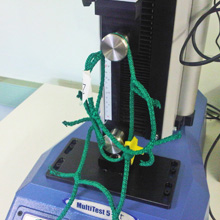 Construction safety netting tensile strength testing
Construction safety netting tensile strength testingProduct safety in the construction industry is critical and test standards are in place to ensure that the protection of workers is maintained. Safety nets, specifically, are used for arresting falls from scaffold systems and also for protection from falling debris. A supplier of these products must adhere to strict quality processes as the nets are returned, repaired and tested for tensile strength, against the manufacturer’s criteria for withdrawal, and industry standards. Age, wear and tear, and UV degradation all contribute to the reduction in the strength of nets over time. The use of bollard grips, designed for the retention of samples of the nature of rope, cord, string, fibre, yarn, thread or tape, provides secure clamping of the individual net cell whilst minimising the risk of “jaw break”. Performing these tests at an in-house facility means that nets are set aside for assessment for the least time, those nearing minimal compliance can be monitored, and all those meeting standards have an immediate certification. Additionally, test control software provides consistent speed, force and displacement, acquires detailed data for analysis, and shows an instant pass/fail indication.
Mecmesin Systems: MultiTest motorised test system, large circular bollard grips, Emperor™ (Force)
Case Study: Construction safety netting certification testing
 Marine vessel aluminium frame fastener shear and pull-out strength
Marine vessel aluminium frame fastener shear and pull-out strengthThe marine industrial construction and engineering sector requires stringent testing of the integrity of the fastening systems employed in sea-going vessels. The materials utilised may also be particularly specialised and light weight, thus needing rigorous evaluation to ensure confidence in the strength of the assembly. A bolted aluminium structural element may be tested to accurately simulate its loading in the complex operational environment in order to measure the critical strength of the entire bolted assembly. The weakest element could be the fastener itself, suffering shear failure, or pull-out, or the hole in which the bolt is located could undergo deformation due to the tensile forces and compromise the structure. This testing is thus able to evaluate the lap joint’s performance and provide objective data as to the quality of the batch of supplied fastenings or any modifications to the frame’s cross-section, design or material specifications. Typical shear forces up to 10 kN are able to be handled with appropriately rated wedge grips and a suitably cut-down sample.
Mecmesin Systems: MultiTest motorised test system, 10 kN wedge grip
 Sheet metal welded fastening pull-off failure
Sheet metal welded fastening pull-off failureThe fabricator or supplier of sheet metal products for the construction industry must ensure that the material is able to withstand the forces that may be encountered in all downstream processes in which the raw components may be used. The integrity of fastening systems used in complete assemblies or joints will be influenced by the basic material properties and the characteristics of any coating, such as a non-corrosive treatment. The testing to failure of welds to ensure they remain sound and crack-free in service provides vital feedback into the manufacturing process and allows the confident specification of welding parameters for safe usage of the raw steel. The use of a computer-controlled testing system to record the peak force incurred before pull-off failure enables quality compliance to internal or international test standards.
Mecmesin Systems: MultiTest motorised test system
 Metal case handle and lock hasp operational strength
Metal case handle and lock hasp operational strengthThe functional attachments of transit packaging products: handles, locks, latches, hasps and clips, etc. are essential to the operation of the container. In the case of a military implementation – such as an ammunition case – it is imperative that these components perform as intended. The non-destructive testing of every production item for such a critical article, would also require a system that can hold the container securely yet allow swift change-over time between tests. In order to test both the handle and hasp of the locking mechanism for resistance to pull-off forces or material failure under tensile load, large and robust custom fixtures are required to grip the unusually-shaped features of the case. A console-operated test stand is suitable for a production environment, with the test programs able be run from a touch-screen icon to then apply the required load value for each element.
Mecmesin Systems: MultiTest touch-screen test system
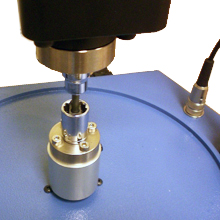 Aerospace vibration resistant nut cycle testing
Aerospace vibration resistant nut cycle testingThe design specification of fastening components such as nuts, bolts and rivets is a complex task, particularly in extreme engineering environments such those encountered in the aerospace industry. The influence of temperature, corrosion, fatigue and particularly vibration are significant factors affecting the reliable and safe performance of the joint. Nuts which are resistant to vibration loosening through provision of prevailing torque are one key design solution. Cyclic testing of the bolt and nut fastening may be achieved with a computer-controlled torque test stand, which is able to accurately and repeatably measure the resistance torque as the nut is tightened and loosened. Should the measured torque to too high, then wear rates would be excessive, too low and the nuts would back off too easily and risk compromising the integrity of the joint. The capability to capture the data throughout the multiple cycle test program and the reporting of the characteristics graphically provides greater understanding of the forces at work, an insight into the fatigue life of the fastener design and increased confidence in the quality assurance process.
Mecmesin Systems: Vortex-i computer-controlled torque test system
 Surgical suture thread tensile strength and elongation at break
Surgical suture thread tensile strength and elongation at breakIn the biomedical engineering industry, the reliable performance of surgical sutures is vital to wound healing and hence the wellbeing and recovery of the patient. Differences in gauge and material constructs (e.g. hybrid metal wire/polymer yarn, or other specialist textiles) are required for different purposes, with functional requirements such as being absorbable/non-absorbable or antimicrobial also affecting the physical qualities of the thread. The measurement of the strand’s elongation at break and the force required to snap the thread provides an objective and comparable method of evaluating these advances in medical technology. To successfully test the ultimate tensile strength of the fibre, it must be ensured that the grips securely hold the sample, whilst being light enough to allow the use of a loadcell with the optimum accuracy for the force range. Any slippage will compromise the precise measurement of the elongation, which may be a critical parameter in the back-to-back comparison of alternative constructs. The use of a computer-controlled force test stand with specific fixtures allows healthcare product OEMs to optimise the design of medical textiles for effective healing and minimal cosmetic impact.
Mecmesin Systems: MultiTest computer-controlled test system

Closure torque testing involves a range of tests for events designed into screw caps, lids and unthreaded stoppers. It can include a measure of the turning force required to initiate twisting, possibly to overcome safety features (e.g. CRC Types I and II) and tamper resistance features, and also to secure the closure. Other rotational systems, for example bearings, also benefit from the evaluation of the required torque to turn—both breakaway and running torque. Accurate measurement of the torque characteristics of these systems requires alignment of the rotational components with the grips and fixtures of the testing equipment. In the case of large or irregularly shaped products, custom designed fixtures may be needed to assure concentricity of the closure with the crosshead, and permit adequate clearance throughout the complete angle of rotation performed in the test.
Mecmesin Systems: Vortex torque testing systems with customised testing fixture design

The flexible consumer packaging solution, comprising a squeezable plastic tube with welded seals is a common and versatile option in household, cosmetics, healthcare and food industries. The manufacturer must ensure the long-term integrity of the packaging to contain a variety of products further down the supply chain. Poor quality in the seals will result in product leakage, either during production handling, transport or in use by the end consumer. Compressive burst testing at the manufacturing source may be implemented as part of a series of in-process verifications. An effective process requires a multipurpose probe design to cater for different sizes of package and still exert the stipulated pressure on the welds – this example utilises a cylinder-shaped compression fixture. A touch-screen console test stand facilitates rapid and consistent testing at the production site, by a simple button press to select pre-programmed routines. The results analysis software can indicate pass/fail conditions and highlight the onset of out-of-specification conditions.
Mecmesin Systems: Touch screen force test systems
Case Study: Flexible Packaging Seal Strength